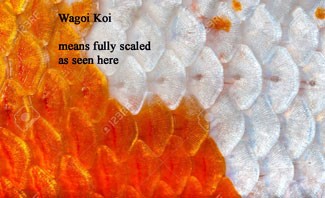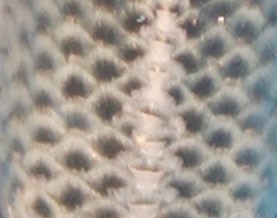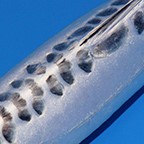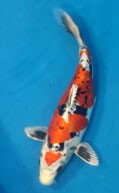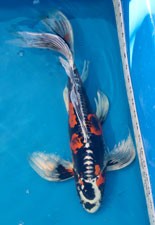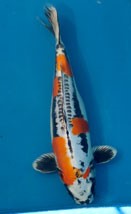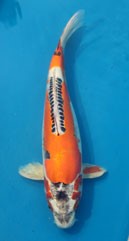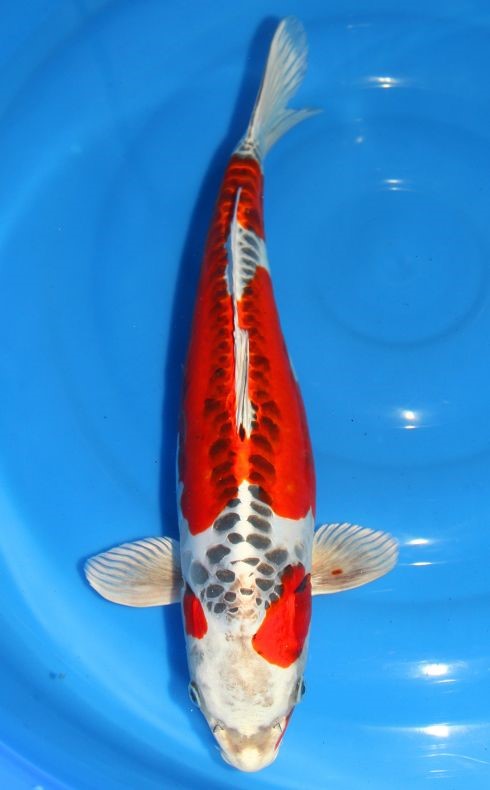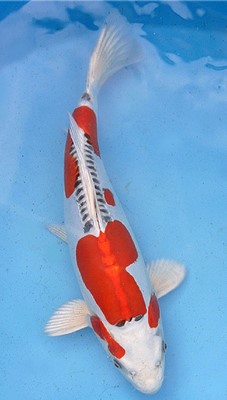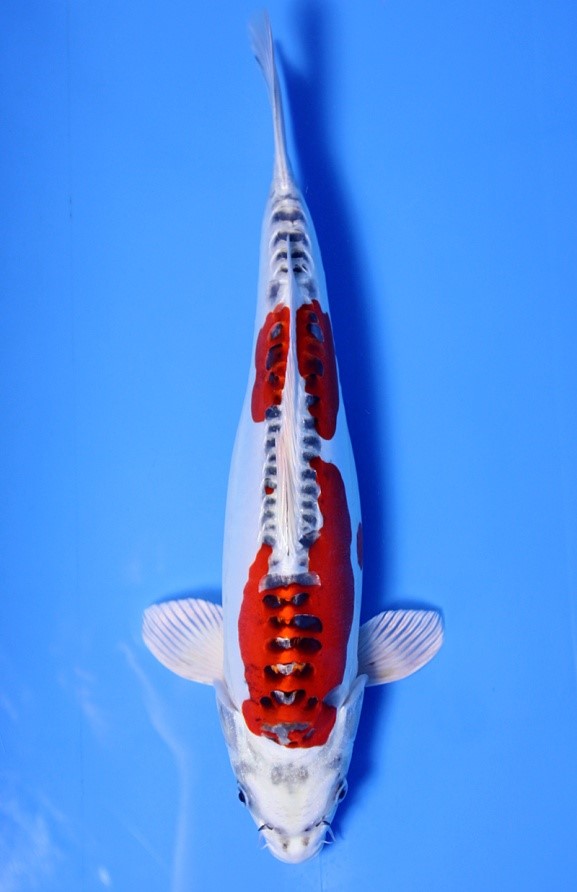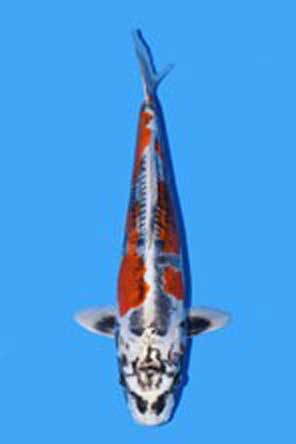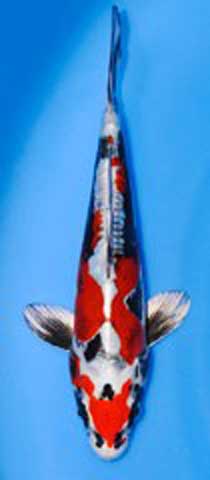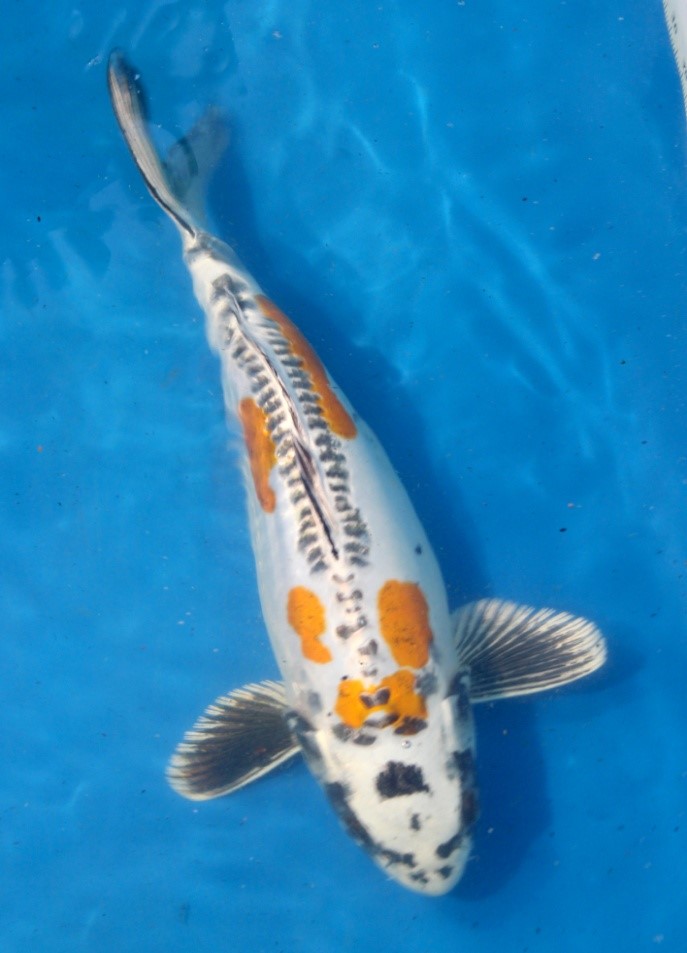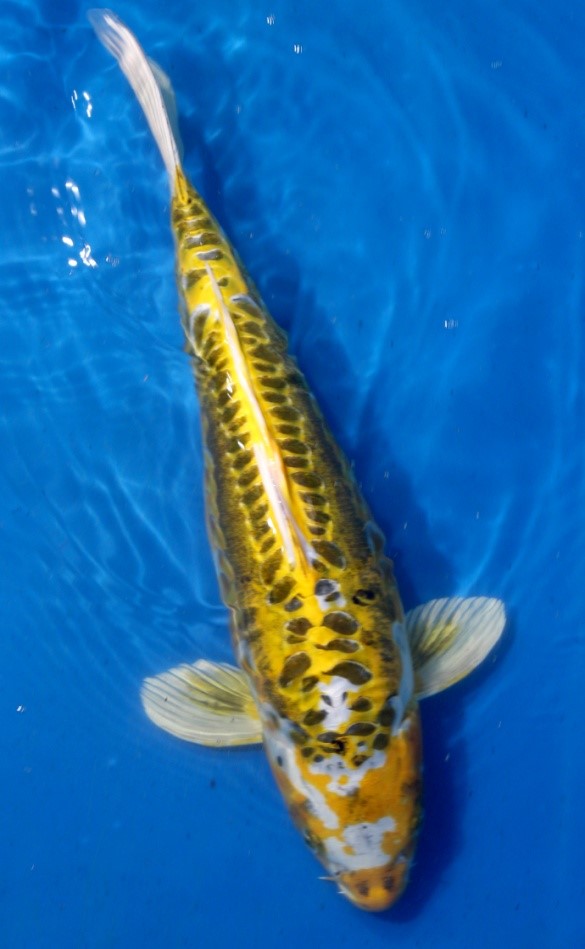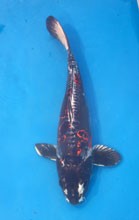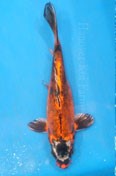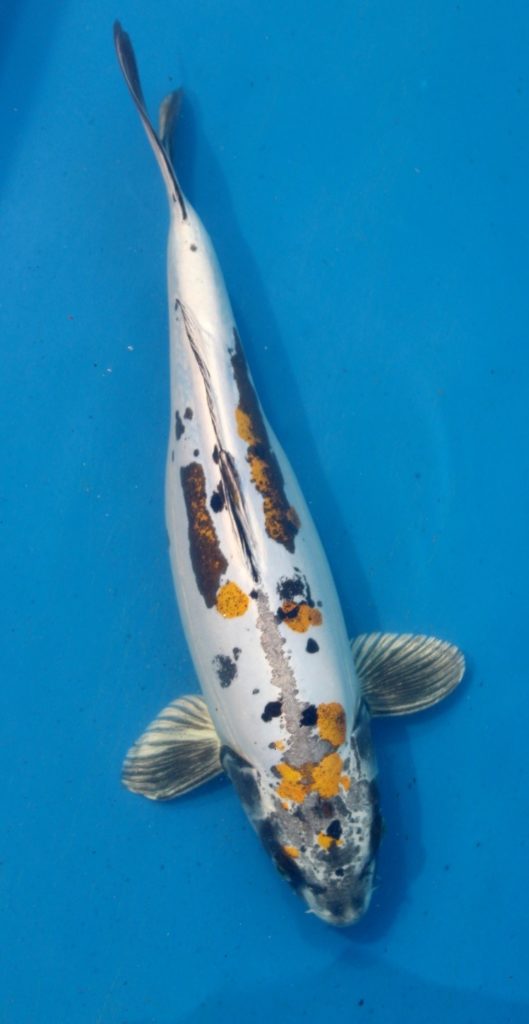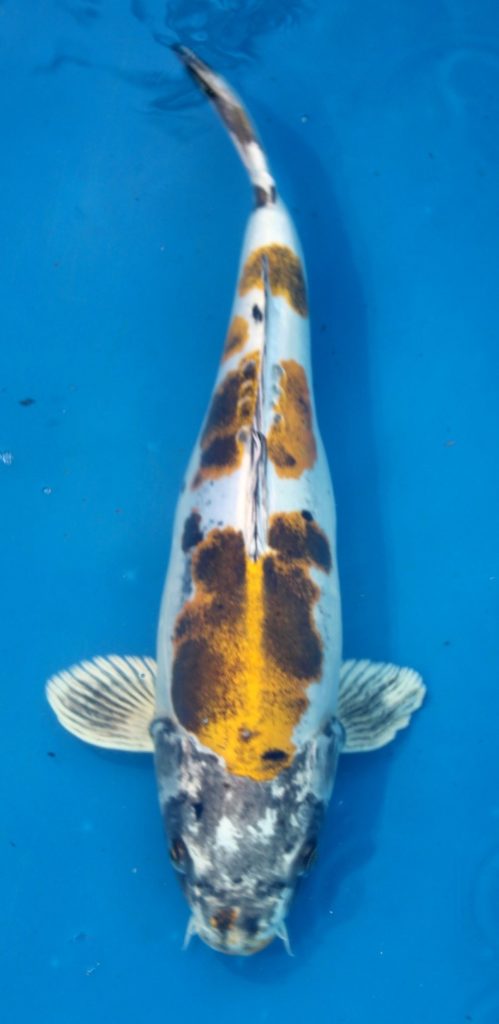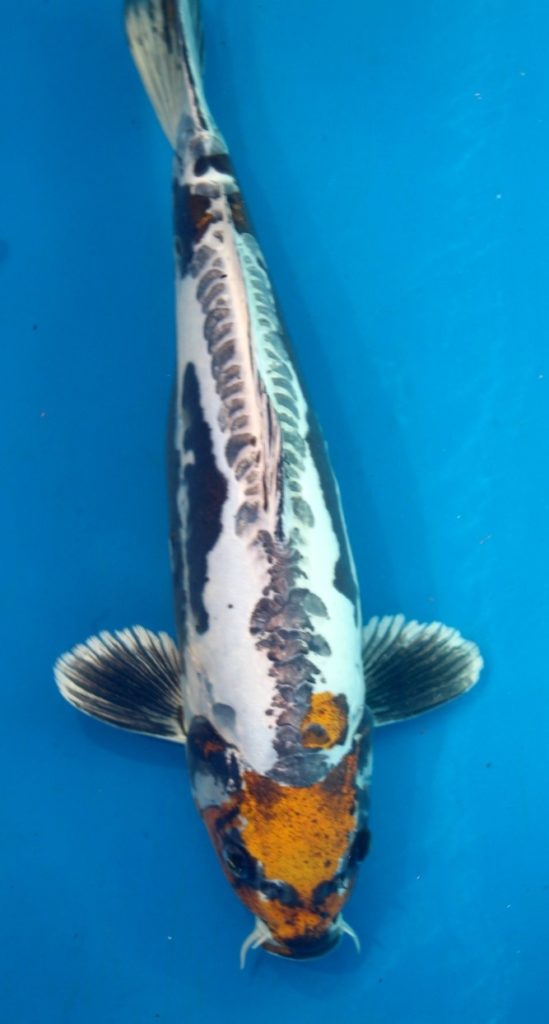Koi Breeds Commonly Misidentified
By John Fornaro
Hanover Koi Farms
Koi identification can be difficult at times for many hobbyists. Even among some “professional” Koi dealers there seems to be confusion, and some don’t always know exactly what they are selling. Personally, I see it all the time, especially in places like Ebay, and even on many Koi dealers’ websites. This misidentification is especially common with the doitsu/partially scaled breeds, or variations of doitsu breeds. This article will hopefully clear up some of the confusion for both the hobbyists and the professionals.
The Basics
Before reading this article, I think we should go over some basic information about Koi. As you may or may not know, Koi have scale variations. A fully scaled Koi is called wagoi (wa-goy), and “scale-less” or “partially scaled” versions are called doitsu (doytz).
See Figure A below.
Figure A: The two main scale varieties of Koi
Any scales that doitsu fish may have, by comparison, are much larger than those of a wagoi Koi. This is due to the doitsu Koi being originated from the German Mirror carp which had these large scales on parts of its body. The rest of the fish is simply skin like that of a catfish . When crossbreeding Koi to the Mirror carp, these scale characteristics were passed down as well. Thus the creation of doitsu Koi.
A doitsu Koi can have only a single row of these large doitsu scales running down the back, and they can also have a single row running along each side at the lateral line in addition to the row down the back. The lateral line is on the side of the fish about halfway up the side from the belly. They can also be completely scale-less, and these are called “Leather Doitsu”. Many, but not all breeds of Koi come in both doitsu and wagoi/ variations. If you don’t know this already you should first read this linked article for more details on these basics; https://hanoverkoifarms.com/about-koi/.
Understanding that article will help you better comprehend the information I am about to explain to you on the proper identification of some varieties/breeds of Koi. Knowing that some breeds have both wagoi and doitsu variations, also be aware that some actually change names from the wagoi to the doitsu version of the breed.
The Ginga breed, for example, is a wagoi breed, but the doitsu version of that breed is called a Kikokuryu. However, many breeds keep the breed name and simply have the word “Doitsu” in front of the breed name. For example: “Kohaku” and “Doitsu Kohaku”. The word wagoi is seldom used anymore as an adjective. Speaking of Kohaku again, you would simply call a scaled Kohaku a “Kohaku” and you would normally not call it a “wagoi” Kohaku. Only the word Doitsu is used to specifically name a breed type. In the case of Kohaku it would be called a Doitsu Kohaku, and the scaled version would simply be called a Kohaku. So if you just say Kohaku it is a given you mean a “wagoi” Kohaku. If it were a Doitsu, you need to call it a Doitsu Kohaku. Another way to put it is if you don’t specifically say it is a doitsu version it is assumed to be the wagoi/scaled version.
With the breeds that change names from the wagoi version to the doitsu version, you do not need to use the word doitsu in front of the breed name. This is because when they change names it is known that the doitsu version is a doitsu. Again using the Ginga and Kikokuryu as an example, it is known by the name alone that all Ginga are wagoi and all Kikokuryu are doitsu. So you would not call the Kikokuryu a Doitsu Kikokuryu. Please refer to the previously linked article for more details about it.
Doitsu or wagoi, some of this misidentification between breeds is simply due to a lack of knowledge, but in many cases, some breeds can look similar to other breeds depending on the age of the fish and other factors. One of these factors is that when Koi are young, they can start out looking like one breed, but as they grow and mature, colors and patterns change or appear and show that they are actually another breed: the breed they were truly born as according to their genetics. In these cases, depending on the age, many times only the breeder can tell you for sure what breed they are when speaking of some young doitsu and even wagoi breeds. I will now take some time and explain the differences in a few of these breeds/varieties that are commonly misidentified. This article will factor in age and quality as well, when it comes to proper breed identification.
Some Commonly Confused Breeds
Below are a few of those commonly misidentified Doitsu breeds (See Figure 1.) Can you identify all ten of them correctly? In these examples I have shown all doitsu breeds, or variations of doitsu breeds, but will touch on the wagoi/ scaled breeds as well, because some are relevant to telling a complete story on proper identification.
Figure 1

So how do you think you did as for identifying them correctly? If you need some help, here is a hint. I can start by telling you which breeds are in the photos BUT in no specific order. This will make it easier for you to apply the correct breed name to the correct fish but the names are not is the same order as the photos. If you want to cheat, then there is an answer key photo at the end of this article.
Kikokuryu Doitsu Gin Matsuba
Beni Kikokuryu Doitsu Hariwake
Doitsu Kujaku Doitsu Kin Kujaku
Doitsu Ki Matsuba Kikusui
Kin Kikokuryu Doitsu Kin Matsuba
If you are struggling to identify all of them correctly then this article will help you. It may even help some of the more advanced Koi enthusiasts out there. This type of information can be very difficult to explain in written form. For this reason I would read this article very carefully, and slowly so as you can properly digest all of this information. You may even have to read it multiple times.
Also know that there are so many variables involved in Koi identification it can seem overwhelming to some beginners. I hope I can help clear up some of the common misidentifications of Koi that I see all of the time. So let’s identify each Koi breed in Figure 1 one at a time.
Let’s Begin :
Fish #1 from Figure 1 Doitsu Gin Matsuba
Figure 2

Doitsu Gin Matsuba is pronounced (doytz-jin-mot-soo-bah)
A high quality Doitsu Gin Matsuba will have a pure metallic white, almost silvery body, and a line of Doitsu scales down the dorsal line (top of back). These scales can be black, gray, or even blue depending on the age of the fish. When the fish matures however these scales should and will become black. I will explain later why the scales can be different colors depending on the age of the fish. In higher quality specimens the scales should be perfectly aligned with no scales out of place or missing. The one in the photo (bred by HKF) is a pretty high-quality example of this breed. The most important thing is that there should be no other black on the fish other than the scales down the back. Any other black on the body is a fault and/or might even make it a different breed altogether. We will discuss these other possible breeds shortly, as well as how lower grade fish of each breed can also cause misidentification.
Gin Matsuba (wagoi) & Doitsu Gin Matsuba
To better understand a Doitsu Gin Matsuba, we need to discuss the wagoi version first: called simply “Matsuba”. This will better help you see how they are bred to the doitsu variation, and exactly what traits they are supposed to have and pass on to the doitsu version.
Both wagoi and Doitsu Gin Matsuba are classified as a metallic breed and fall into the group of Hikari Muji,( AKA Hikari Mono) as classified by Japanese show standards. Gin Matsuba wagoi are a metallic white-based Koi that have black reticulation within each scale. Each scale is mostly black with just a portion of the outer edge of the scale trimmed in white. Picture a black dot near the center of each white scale (see figure 3). The black will normally take up about two thirds of each scale minimally, but not always.
As you can see in the photo, this gives the wagoi version a look of an open pinecone. Hence the name Matsuba, which translates to “pine tree” and thus pinecone as the Japanese breeders use it.
Figure 3 Gin Matsuba wagoi

The word “Gin” simply means “silver” and they use this to describe the metallic white base color of the Gin Matsuba which has a silver sheen to it. This is especially true in the doitsu version of the Gin Matsuba, as the skin should especially have this silver hue to it if it is of decent quality. You will hear many Koi people say the Gin means “white”, but that is not totally true. Gin is used to describe a particular kind of white that has the metallic silver tint. Alternatively, flat, non-metallic white is called shiroji.
The photos below in Figure 4 are of what the scales of a high-quality Gin Matsuba wagoi (left) and Doitsu Gin Matsuba (right) should look like up close. Later you will see how important this is in judging quality, as well as in breed identification. Also note that the photo of the wagoi Gin Matsuba on the left is a young fish, and the black is not fully developed yet. As this fish matures, the black should become “inky” black and much more prominent in tone and contrast. The Doitsu Gin Matsuba pictured is a more mature fish by comparison, and you can see how the black/sumi has developed further than the wagoi example. You can also see the “silver sheen” in the skin of the doitsu. Let’s discuss the wagoi Matsuba first.
Figure 4
The overall breed Matsuba, doitsu or wagoi can come in four color variations; Gin /white (as we are discussing here), and also Ki/yellow, Kin/orange, and finally Aka/red. In Figure 5 below we have the wagoi variations of the Matsuba breed. Each color variation has its own specific name. So from left to right we have ; Kin Matsuba, Gin Matsuba, Ki Matsuba, and finally Aka Matsuba. As you can see, they really do resemble colorful open pinecones.
Figure 5; Wagoi Matsuba Breed Variations

Understand that all four of these particular examples are of a very high quality, and almost perfect specimens. You have to take this into account and realize that most of the Matsuba sold are not of this high quality. This variance in quality can cause different looks for sure, but you should still be able to see the basic colors and reticulation even in lower quality specimens. In most cases the reticulation and colors will not be as clean and balanced-looking in lower quality Matsuba. We will discuss the less than perfect specimens later, as these can also look similar to other breeds and cause more confusion in breed identification.
Now in Figure 6 you can see the Doitsu variations of this breed Matsuba. In the case of this breed, the names remain the same as the wagoi versions except you put the word “Doitsu” in front of the word Matsuba. Hence from left to right in Figure 6 we have Doitsu Kin Matsuba (sometimes called Mizuho Ogon), Doitsu Gin Matsuba, Doitsu Ki Matsuba, and finally Doitsu Aka Matsuba.
Figure 6

If you look closely at the wagoi example in Figure 5 as compared to the doitsu photos of the Matsuba in Figure 6, you can begin to see how they transform from a fully scaled version to the partially scaled Doitsu version.
Matsuba Summary Thus Far
So far, we have learned that the wagoi, or scaled versions, of the Matsuba breed are a single-base-colored fish in orange, white, yellow and red. On top of these base colors there is a pinecone pattern of black (called sumi) within the scales. This creates the reticulation/fishnet look in the overall scale pattern. With this in mind understand that the doitsu version should be similar, but minus the fish-net reticulation due to the lack of scales. That leaves us with a single-colored base on the body with black doitsu scales down the center of the back. It is acceptable for the scales of the doitsu version not to have the thin trimming of white around the scales’ edges, and instead be solid black. What is important about the doitsu version of this breed is the only black should be within the doitsu scales and not in the skin on the body. This is a critical factor in judging this breed’s doitsu variation for perfection, or for comparing it to other similar looking breeds.
Only the Doitsu scales should be black in a Doitsu Matsuba of any color variation
One exception is that it is acceptable to have some black in the pectoral fins and tail. This is not considered a big fault when judging Matsuba, but it is considered a fault. When judging ANY doitsu breed, however, how well the scales are aligned down the back plays a major role in judging quality as previously mentioned. You want them all in a straight line with no scales missing or out of place in the line.
Where the Confusion Begins with Gin Matsuba
Young Gin Matsuba
As with many breeds of Koi, young Matsuba, doitsu or wagoi, start life looking a little different than they do when they are mature. Many wagoi and Doitsu Gin Matsuba for example, start out looking like Platinum Ogon or Doitsu Platinum Ogon. This is a pure metallic white fish with no black at all. This confusion is because the sumi in the scales of the young wagoi Matsuba can come later as the fish matures, and the same is true for the doitsu version. Also, this black comes at different ages for different individual fish. With some individuals, you can see the underlying black beneath the white even in young fish, and many times this will make the white color appear blue. That is because the underlying black, which is trying to show through the white, appears blue due to the dilution of the white color above the black color. So if you see this blue tint you should further investigate. One trick we use here at HKF is to put the young fish in a white bucket or tub. In the case of a young Gin Matsuba, when in the white bucket you will see the underlying black more as black instead of the misleading blue color. This is because the white bucket offers a much better contrast as compared to other background colors. Below in Figure WB you can see just how effective the white bucket trick is! When you see the black in the scales, even though it may be faint, this is a sure sign it is a Matsuba and not a Platinum Ogon. This underlying black will eventually develop into true black as it matures/finishes, and rises to the surface of the scales.
We also use the white bucket trick to look for imperfections in colors, scale patterns and other things. The white bucket will greatly amplify even the slightest imperfections. So much so that even the best quality fish can look bad in the white bucket because of this exaggeration of any faults. So don’t be fooled by this when judging quality of fish. You do not want to turn away from a really good fish because it may look like crap in the white bucket. Most fish look like crap in there. This is one reason we use blue tubs for normal viewing of Koi. It is a more neutral color and shows all the colors and patterns of most breeds very well, and more importantly it shows how the fish will truly look in your pond. Nothing beats the white bucket though for looking at young fish to determine the true breed.
Photos Show the Evidence More Clearly
So look for this when judging a Tosai (fingerling) white fish to determine if it is in fact a Matsuba or a Platinum Ogon, or even some other breeds like a Bekko or Kikokuryu.
Figure WB Note that all the photos in Figure WB were taken within minutes of each other. There is no trick photography here. This is how drastic the difference is when using a white bucket to better determine the true breed. This is especially true with young fish. Each pair of photos that are side by side are the same fish! So you can see we used three fish total for these examples.

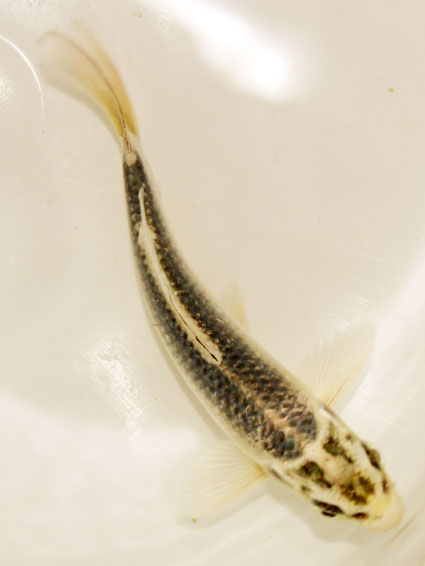

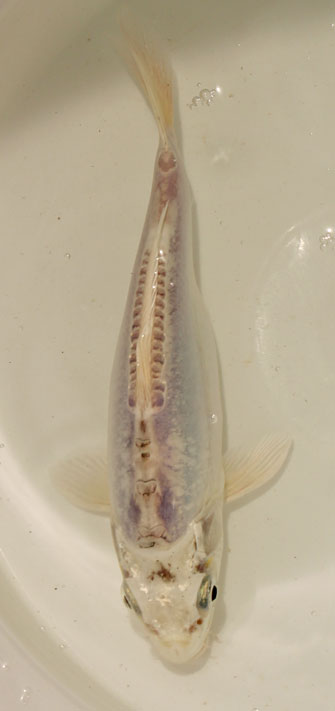
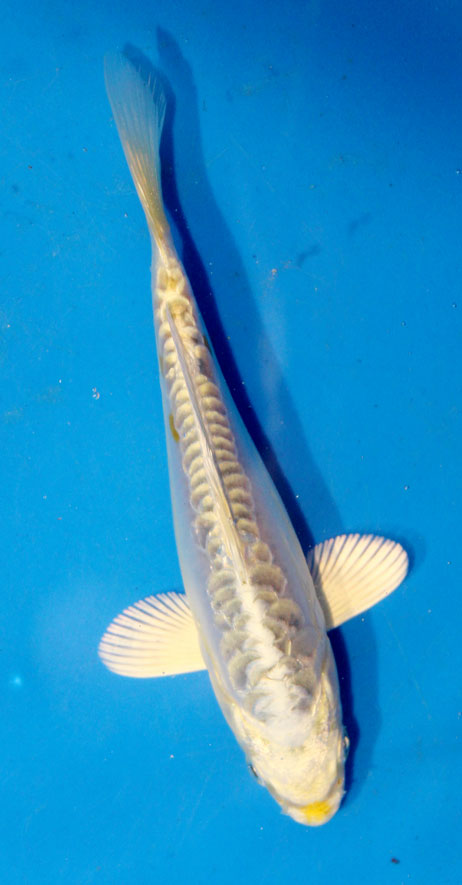
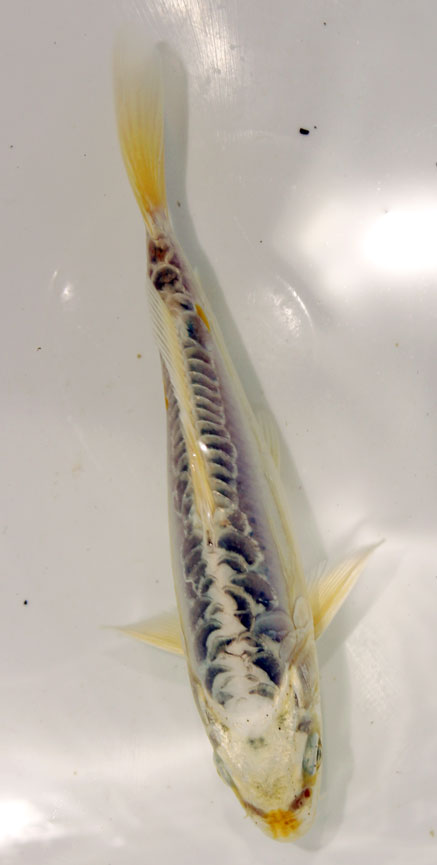
Here is a young Gin Matsuba Butterfly Koi in Figure 7. If you look closely, you can barely see the black starting to appear. However if you put this fish in a white bucket you would be able to better see it is a Gin Matsuba because that faint black will “pop” in the white background of the bucket. Many places that sell Koi mistakenly call these young Matsuba, Platinum Ogon and they are incorrect. It is a Gin Matsuba, and will prove itself to be one in the future as the black surfaces.
Figure 7

My point is proven further with this particular Gin Matsuba Butterfly (Figure 7) because I had no photos around to depict a young Gin Matsuba. Therefore, I searched online for one. I found this Butterfly, and the place selling it advertised it as a Platinum Ogon! This is incorrect. It is a young Gin Matsuba.
The Ki Matsuba wagoi
In Figure 8 we have a young Ki Matsuba wagoi. You can see the black reticulation better than the previous young Gin Matsuba Butterfly. Both are good quality fish with clean, smooth, full colored heads and balanced reticulation of the scales. Once again, put this fish in a white tub or bucket and that faint black will show much better. So, I hope these places that misidentify this breed try the white bucket trick!
Figure 8
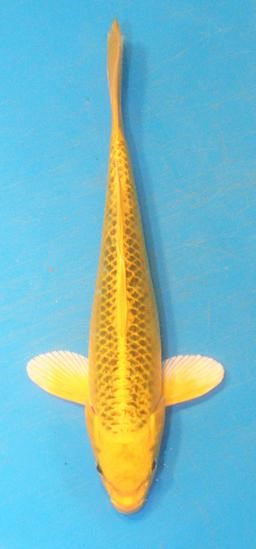
So, we have learned that young wagoi and Doitsu Gin Matsuba can be misidentified as Platinum Ogon and vice versa. However, there are other look-alike breeds that come into play as a Gin Matsuba matures and “finishes”. ( “Finishing” is simply when the fish matures and all the colors and patterns become fully developed.) Before I get into these however, we need to discuss quality, or grades of Koi breeds.
Remember that the size and age of a given fish is a critical factor in judging quality as well as breed identification.
How Quality Affects Identification & Value
Remember when we discussed how the quality of a given specimen of a certain breed comes into play with the breed identification? Well this fact is not only important for breed identification purposes, but also for putting a dollar value on a particular Koi. I have a detailed article called About Koi , under the paragraph titled Perceived Value of Koi. This article discusses Koi value in more detail, but I will touch upon it here as well.
Breed Quality & Culling
Every true professional Koi breeder has to cull through the offspring of a given spawn. This means that as the Koi fry grow, we catch them all up a few times a season for inspection. When we do this, we look at every single fish for quality with respect to its breed. In the Koi world, each breed has a standard that they are judged for in accordance with the breeder’s desired look, or as the Japanese standards have dictated. This is a fact in the selective breeding of most domestic animals. In the Koi world, we cull primarily to reduce the numbers of fish we are propagating. This is because a single mature female Koi can produce half a million eggs or more! We simply would not have enough room to grow out this many fry of one given breed, in a limited given space. In nature, only a tiny percentage of eggs hatch, and even a smaller percentage survive to adulthood (if any). Many of the eggs and fry get eaten by other critters including insects! In a breeding facility, however, most hatch and survive, and this is another reason we have the culling process to reduce overall numbers of fry.
We also cull through the fry to eliminate any deformed offspring or ones that do not contain the traits we are looking for within that breed. A given spawn of a certain breed can put out many very different looking offspring depending on the genetics/bloodlines of the parent fish. Most Koi breeds have long lineages of varied breeds being combined to create a new breed. So this is why there can be offspring that look completely different from one another. We only want to keep the ones that fall in line with our goals for the breed we are spawning.
Even though we are looking for perfection in a breed, this is a rarity amongst even the best breeders in the world. The reality is that we keep a certain percentage of fish that we have deemed “of acceptable quality”, and we then further sort them into varying grades. These grades dictate the monetary value of a given fish. The closer the fish is to perfection, the higher the grade, and thus the more monetary value that is put on it. On average, a good breeder will only end up keeping a small percentage of the total offspring. Depending on the breed, this is usually a maximum of 10% and maybe an overall average of 5% among all breeds spawned. So, as you can see, only the smallest percentage of the best quality offspring are kept and sold. This is the case when speaking of true professional Koi breeders, and especially Japanese Koi breeders.
However, many American breeders do not know how to cull properly. Either this, or they do not want to put the time and labor into this tedious task of looking at every single offspring! Some get greedy and want to keep all the offspring including the culls, and sell them for profit without sorting them at all (even for deformities). This is true American capitalism at its finest. These breeders are selling very overpriced Koi of very low quality. All they end up doing is polluting the market, and hobbyists’ ponds, with low grade fish. In the long run, this will destroy the Koi hobby as the Japanese intended it. These particular American breeders and dealers also happen to be the ones that are commonly misidentifying the breeds they sell. Needless to say, you should avoid these types of breeders and dealers.
Another thing many shoddy Koi breeders do is to give cute, made-up breed names to low-quality fish for marketing purposes, when in fact they are simply low-quality Koi. You will see made up names like “Peanuts”, “Blue Kujaku”, Blue Sapphire” and “Gold-Crowned Matsuba” to name only a few of these marketing ploys. These are not breeds of Koi, they are simply made-up names put on fish to make them seem more valuable to the unknowing hobbyist. Most of these are either cull-grade fish and/or low-grade, and/or misidentified breeds.
So that is enough about the dark side of Koi. I will show you a few photos to help you get a better idea. Since we are discussing the Matsuba breed, I will show you photos of low grade wagoi Matsuba. All of these low-grade fish shown would be culled at HKF, and long before they got to this size.
Low Grade Gin Matsuba (Figure 9)
As you can see, this fish has failed to properly produce the balanced reticulation in the scales. There is no visible fish net pattern. Each scale has too much black and too little white. Keep in mind that these are young fish and more black will come over time as they mature. At that point the back of these fish will be pretty much solid black with only a tiny bit of the base color showing, if any, as randomly -peppered speckles throughout.
Low Grade Ki Matsuba (Figure 10)
Just as with a low-grade Gin Matsuba, this Ki Matsuba has the same problems. It is a slightly better fish than the Gin Matsuba shown, but not by much. This would still be a cull at HKF.
Figure 9 Figure 10
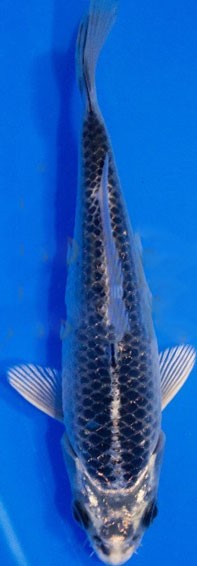
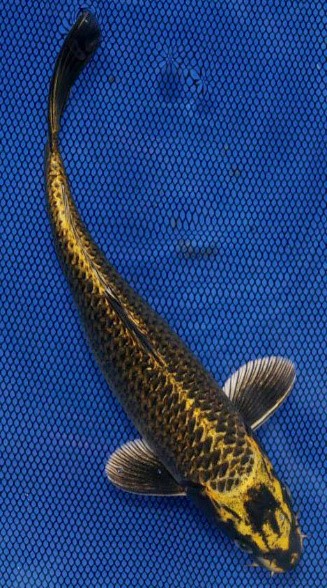
Figure 11 below is a VERY LOW GRADE of Koi, that this particular breeder named a “Gold Crowned Matsuba”. This is one of those made up marketing names. There is no such breed of Koi in reality. These are actually the culls of a Matsuba wagoi or doitsu. They are Matsuba that fail to have any of the reticulation in the scales and instead are almost solid black throughout. They have very poor skin quality as well. Places sell them as something special to make you want to buy them and even pay a premium for them! Don’t be fooled. While this Butterfly may look interesting to some folks now, it is a young fish and I can assure you as it grows it will get extremely ugly and speckled. Then we jokingly call them “Specklegoi“
Figure 11 “Gold Crowned Matsuba”

Misidentification of Wagoi Matsuba
As for the scaled version of the Matsuba, the Gin Matsuba and the Aka (red) Matsuba are the two most commonly misidentified ones. The wagoi Gin Matsuba is often misidentified as a Ginga (another metallic black-and-white scaled breed), and vice versa (see Figure 12 below). Basically, the sumi/black of the Ginga is temporary and changes continuously back and forth from a light phase gray to a dark phase black. We here at HKF call this “changing sumi “Henka” sumi, and we will discuss this in more detail later. These changes come about with changes in water temperature, lighting, background color of the system they are in, and water chemistry. In colder water for example, the black will darken, and in warmer water it will lighten. This is because the Ginga is simply a scaled Kikokuryu. We will discuss this further, as well as Kikokuryu and their changing sumi later on in this article.
The primary difference between a Ginga and a Gin Matsuba is that the sumi on a Matsuba does not change. ( other than as the fish matures.) With maturity it darkens as shown in previous photos of Matsuba. This change is permanent. Alternatively, the sumi of a Ginga will constantly change back and forth from a light phase to a dark phase for the reasons previously mentioned, and this back and forth change will occur for the entire life of the fish. Also, many Ginga will have black in the fins and tail and most Gin Matsuba will not. Ginga will be a pewter color in their light phase and more black in their dark phase as seen in the photos in Figure 12.
Figure 12 …Ginga Changing Sumi Variations
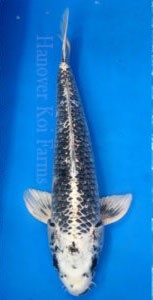
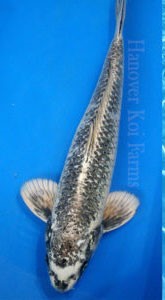
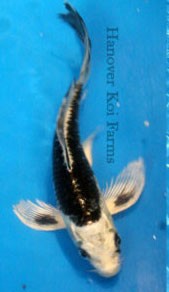
Figure 12: Three photos of different grade Ginga in their various temporary color phases. Depending on their grade and current color phase, Ginga may be mistaken for Gin Matsuba by an untrained eye.
Quality and Proper Identification
Wagoi Gin Matsuba Quality Variations
Different grades of Gin Matsuba can look very different between one another as well, as shown in Figure 13. Balanced amounts of black and white, and also the brightness/darkness of the color, and the arrangement of the scales all contribute to a Gin Matsuba’s quality.
Figure 13 Grades Of the wagoi Gin Matsuba
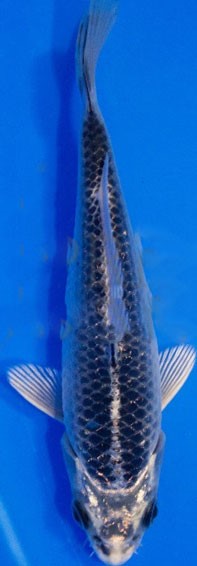
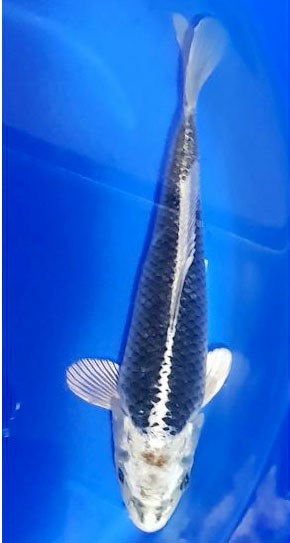
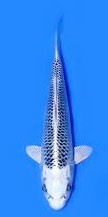
This difference in quality is a major factor in this breed being misidentified with other breeds like the Ginga.
Wagoi Aka Matsuba & Kin Matsuba Misidentification
The Aka, or red Matsuba, and sometimes the Kin Matsuba are commonly misidentified with a variety of the breed Asagi called “Hanna Asagi”. Firstly, a Matsuba is a metallic breed and an Asagi is not. There is no metallic sheen or luster to an Asagi’s colors. That is the first real clue. A Hanna Asagi is simply an Asagi with too much orange or red. This orange or red is called Hi ( pronounced hee). These Hanna Asagi and their variations are common culls of many Asagi spawnings. The Hi on a good Asagi should go from the belly to the lateral line of the fish’s side only. When this orange color creeps up and over the lateral line and also further up and over the back is when they are called Hanna or Hi Asagi. Most are considered are culls, as stated. This is when they are mistaken for Aka, and Kin Matsuba, depending on the shade of Hi, see below in Figure 14 .
Figure 14
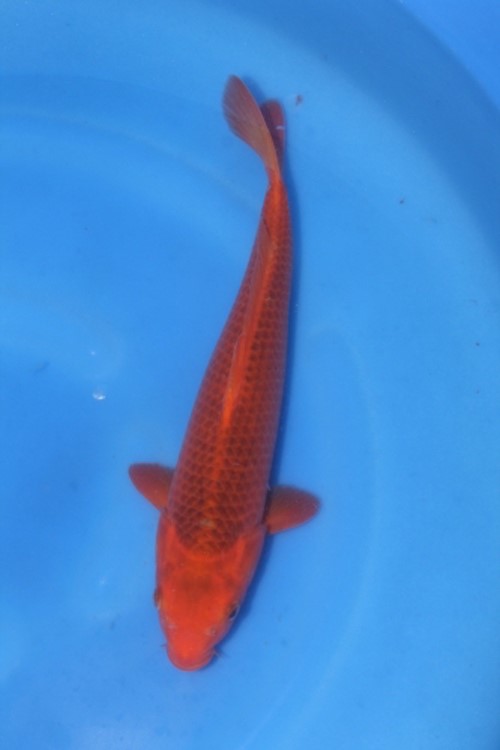
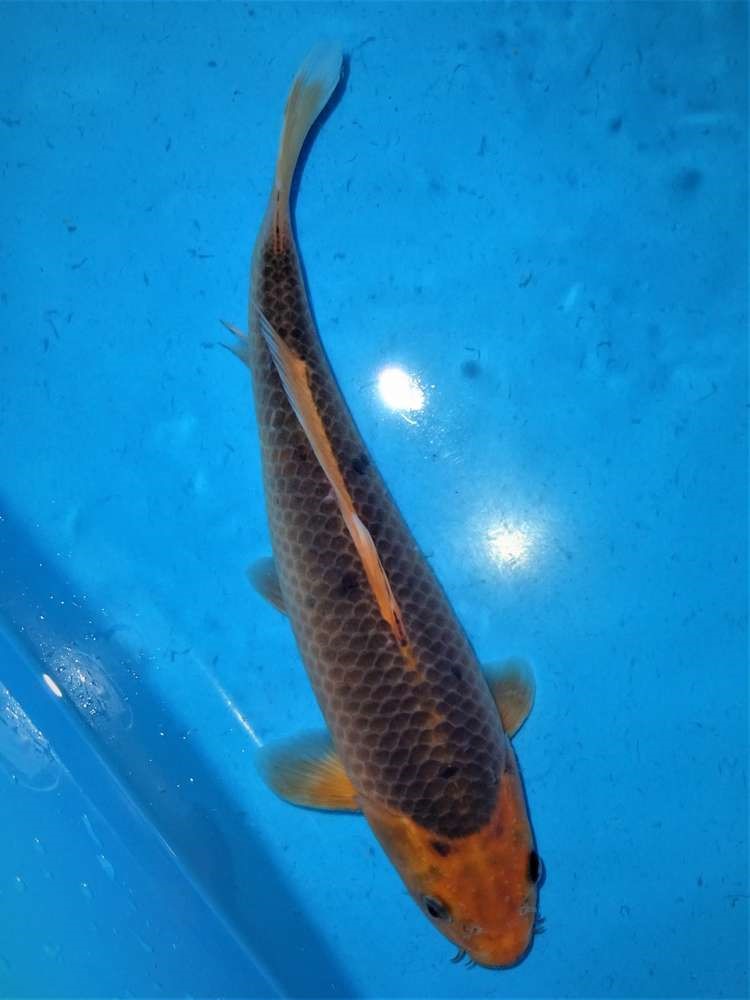
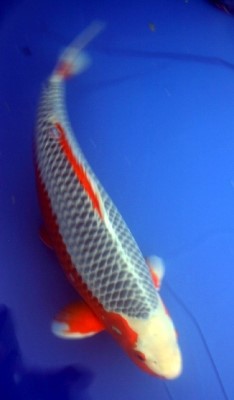
Figure 14: Sometimes low-quality Hanna Asagi’s can look similar to Aka Matsuba, although a typical high-quaity Asagi should appear like the one on the left.
Doitsu Matsuba Misidentification
Now for the misidentification of the Doitsu Matsuba. Remember, just like the wagoi Matsuba, we have four color variations of the Doitsu Matsuba: Kin/orange, Gin/white, Ki/ yellow, and Aka/red. Let’s start with the Doitsu Gin Matsuba because it is fish #1 from Figure 1 (in the beginning of this article). Once again this is a very good grade produced by HKF.
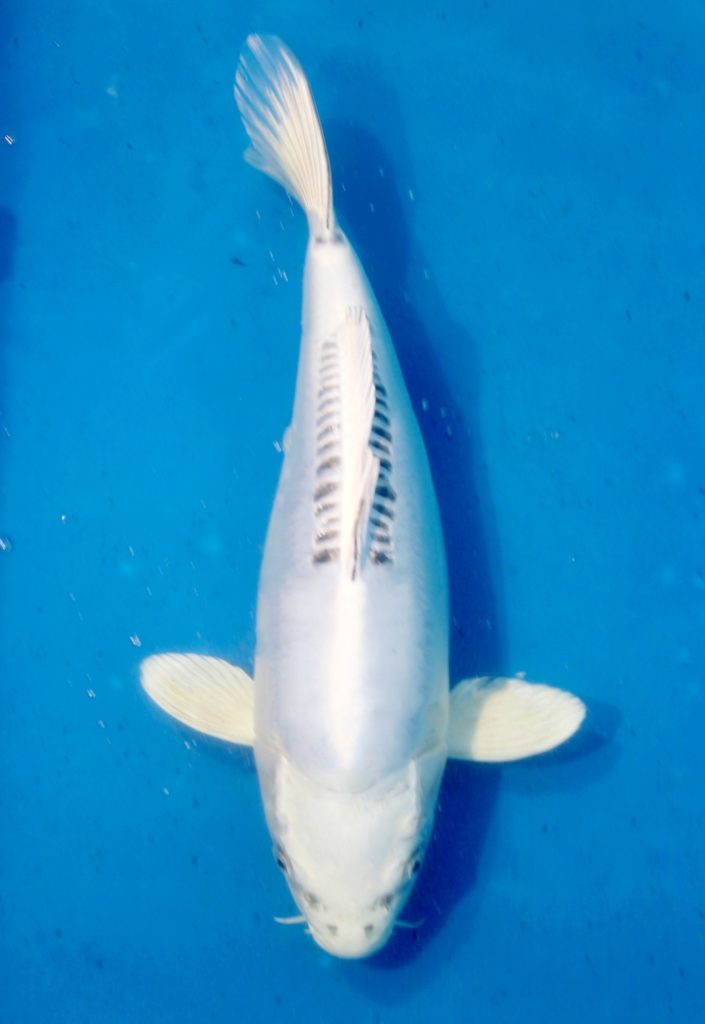
Just as with the wagoi Gin Matsuba, when the Doitsu version is young, it is commonly confused with a Doitsu Platinum Ogon and vice versa. Once again, this is because the scales of some young Doitsu Gin Matsuba do not turn black until they mature to a certain size. Before that point, the scales of the Doitsu Gin Matsuba can appear white, off-white, and even blue or gray depending on the size and age of the fish. This delay in the development of the black is more apparent with the Doitsu Gin Matsuba than with the wagoi Gin Matsuba which can develop the black in the scales at a young age at times. See the photos in Figure 16 to see how they differ;
Figure 16
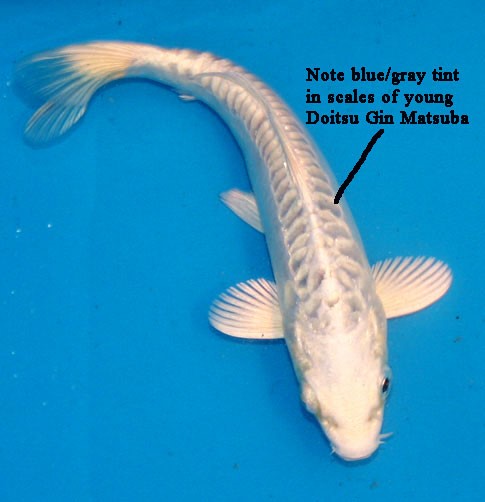
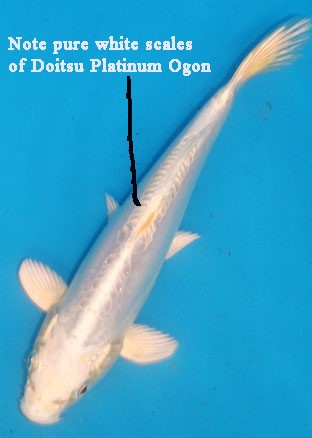
Young Gin Matsuba can be mistaken for you Doitsu Platinum Ogon and vice versa. This is because the Doitsu scales of some young Gin Matsuba do not turn dark black until they mature.
Young Doitsu Gin Matsuba
As you can see in Figure 16, there is a faint gray color in the scales of the young Doitsu Gin Matsuba. If you were to use the white bucket trick with this fish, those scales would show a distinct black or blue hue to them. This is how you know you are looking at a Doitsu Gin Matsuba and not a Doitsu Platinum Ogon. As this young Matsuba matures those scales will change from gray or blue to inky black.
Young Doitsu Platinum Ogon
As for a young Doitsu Platinum Ogon, their scales are white when young and just get whiter as they mature. The same holds true for the body color as well. With older more mature fish you can more easily see the differences in the Doitsu Gin Matsuba verses the Doitsu Platinum Ogon as see in Figure 17 below
Figure 17 Mature Doitsu Gin Matsuba & Doitsu Platinum Ogon
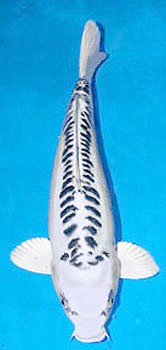
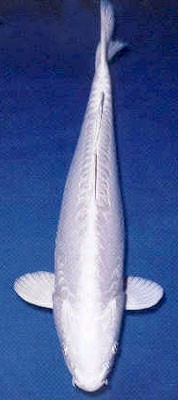
Figure 17: Although they can appear similar when young, after the black darkens on a mature Doitsu Gin matsuba, it looks very different from a Doitsu Platinum Ogon
More Gin Matsuba Misidentification
When it comes to Doitsu Gin Matsuba, the other most common Koi breed they are confused with is the Kikokuryu (pronounced key-ko-koo-roo or key-ko-koo-loo by the Japanese. They pronounce the letter “R” as the letter “L”). Once again, the age and the size of this breed plays a huge role in this misidentification. Here is a side by side comparison of the Doitsu Gin Matsuba & the Kikokuryu (See Figure 18 below;
Figure 18 Doitsu Gin Matsuba & Kikokuryu Comparison
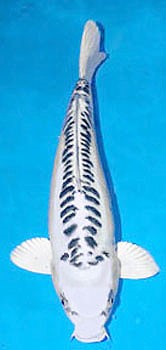
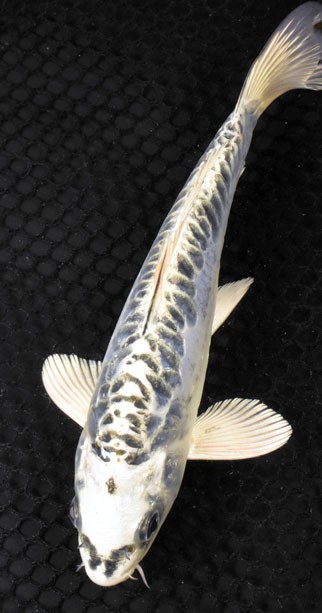
Figure 18: A comparison of Doitsu Gin Matsuba and Kikokuryu
Once again, this misidentification is extremely common. I pulled this photo of a Kikokuryu (on right in Figure 18) from a Koi dealer’s website where it was identified as a Doitsu Gin Matsuba. This is incorrect. Upon closer inspection the difference can easily be seen. If you look closely you can see the “dusting” of black on the sides of the fish. This dusting is what we at HKF call “Henka sumi”, as previously mentioned earlier when we were discussing Ginga Koi. This black will change based on certain variables. It will go back and forth from light to dark based on these variables. We will discuss these variables in great detail later in this article. You can see this better in Figure 19 below;
Figure 19
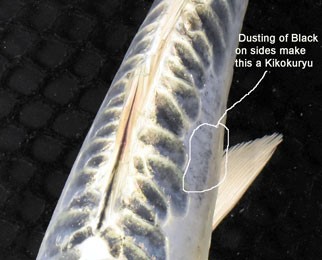
Henka sumi is found on Kikokuryu but NOT on Doitsu Matsuba. While it is possible for a lower grade Doitsu Gin Matsuba to have some black on its sides, the black would not look like a black, gray, or pewter dusting of Henka sumi like it does in the Kikokuryu photo. Instead it would be random “spots” of black, and these spots would not change like those of a Kikokuryu. Therefore, when you see the “dusting” of Henka sumi it is most likely a Kikokuryu and not a Doitsu Gin Matsuba. This dusting of Henka sumi will temporarily lighten and darken substantially based on water temperature and other variables, proving that it is a Kikokuryu. Here are two photos of the same Kikokuryu taken at different times during the year. One photo the fish is in its light phase (warm water) and in the other it is in its dark phase (cold water). See Figure 20
Figure 20 Changing Henka Sumi in the same fish
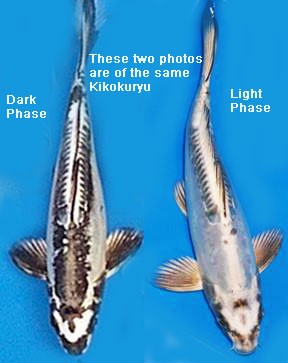
As you can see, this dusting of Henka sumi can and will change drastically. We will discuss this in great detail later in this article when we discuss the Kikokuryu variety further.
Now back to identifying the fish in Figure 1;
Fish #2 and #3 from Figure 1
Doitsu Kin Matsuba and Doitsu Ki Matsuba
The Doitsu Kin and Ki Matsuba are commonly misidentified for Kikokuryu variations. You can see the Doitsu Kin and Ki Matsuba in Figure 21 below.
Figure 21
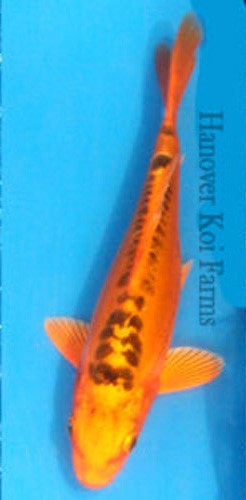
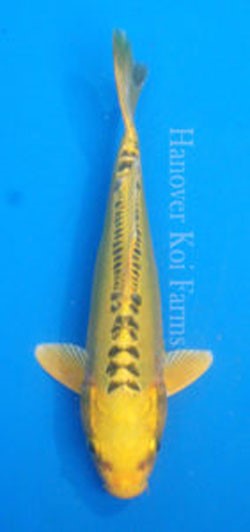
Figure 21: Fish #2 & Fish #3 from Figure 1
As you can see, I have identified fish #2 and fish #3 both as Doitsu Matsuba. This is because they are both just color variations of the Doitsu Matsuba breed. Just as with the Gin Matsuba, these are metallic fish but with a different base color than the “Gin” or silvery white. The Kin Matsuba is orange and the Ki Matsuba yellow.
Again these Doitsu variations of the Matsuba should only have black in the Doitsu scales along the dorsal line (back). This applies to both the Kin and the Ki doitsu versions of the Matsuba, just as with the Doitsu Gin Matsuba. There should be no other black on the fish when judging for quality and/or breed identification in general in most cases. Just as with the Doitsu Gin Matsuba, lower grade variations of these Kin and Ki Matsuba can, at times, have “spots” of black in the skin however. This black is regular sumi and not Henka sumi and it would look like freckles or small blotches. These sumi spots are a major fault in Doitsu Matsuba breeds of any color variation. Also these sumi freckles will not change in shade (ie; lighten or darken).
It is the difference between Henka sumi and regular sumi that is the key identifying factor between proper identification ofthese breeds
Misidentification of Doitsu Kin and Ki Matsuba
Doitsu Kin and Ki Matsuba are often misidentified for the breeds Beni Kikokuryu and/or Kin Kikokuryu. This is especially true when you get into the varied degree of quality or grades of these breeds. For example a low grade Beni Kikokuryu can look similar to a Doitsu Kin Matsuba, and a low grade Kin Kikokuryu can appear similar to a Doitsu Ki Matsuba. As you can see in Figure 22 comparison below between Kikokuryu variations and the Doitsu Matsuba variations, both the Doitsu Kin Matsuba, and the Doitsu Ki Matsuba have no black in the skin and only the Doitsu scales along the back are black.
Figure 22
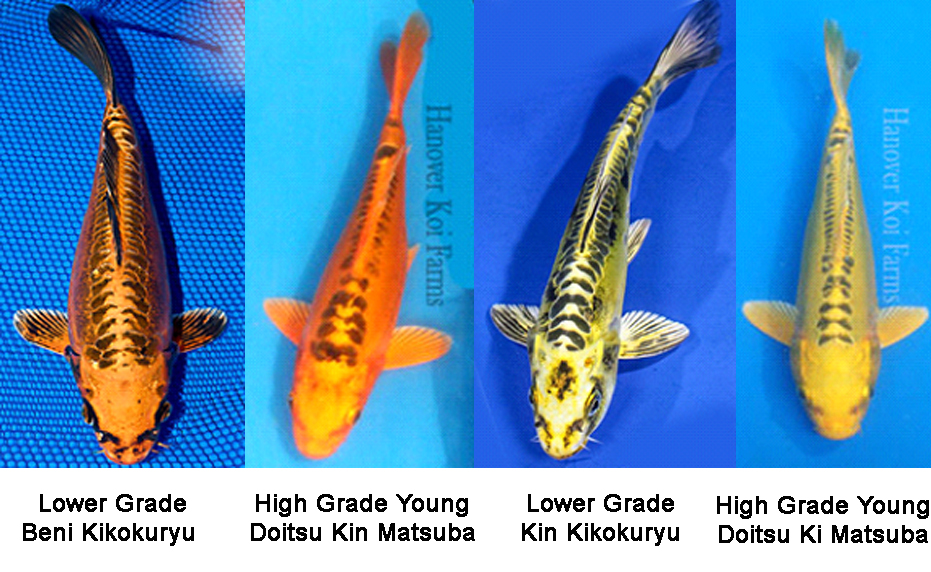
In the Kikokuryu, they both have the Henka sumi, or dusting of black, peppered throughout the sides of the fish. This is the primary difference between the breeds. The only other possible way a Doitsu Matsuba would have Henka sumi is if it had Kikokuryu blood in its genetics. If this were the case it would be a “mutt” so to speak, and technically not a pure breed of either a Kikokuryu or a Doitsu Matsuba.
So once again it is the Henka sumi or lack thereof that is the key identifying factor between these breeds
Fish #4 in Figure 1
Doitsu Hariwake
Figure 23 Doitsu Hariwake
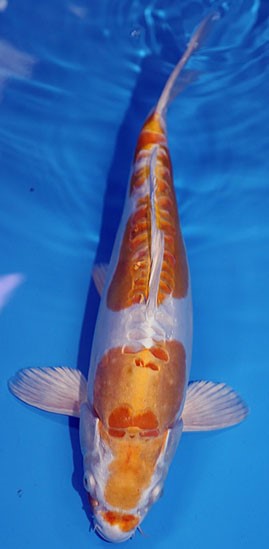
So fish #4 from Figure 1 is a Doitsu Hariwake. Hariwake is another variety that comes in both wagoi and doitsu versions. Hariwake are a metallic white-based fish with a Kohaku/dorsal- type pattern (blotches across back) of either orange, yellow, or red. So let’s look at Figure 24 for an example of a dorsal pattern and talk a little about this;
Figure 24
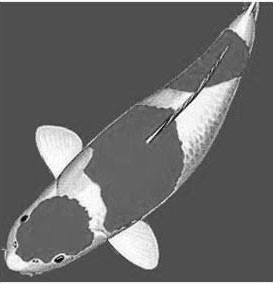
Note the three steps/ blotches that wrap around the top of the fish and down both sides. This one happens to be a three-step pattern, but there could be up to six steps. This type of pattern is called a dorsal or Kohaku type pattern. This multi-step pattern is the ultimate goal when trying to produce a fish with a dorsal pattern , and this is especially true with the breed Hariwake, be it wagoi or doitsu. However a Hariwake can have a different style of pattern as well, called a lateral pattern depending on their lineage. Figure 25 shows a lateral-type pattern. Note how it runs along the sides of the fish and above the lateral line(center line along sides of fish) more like stripes, and does not creep over the back like a multi-step dorsal pattern.
Figure 25 Lateral Pattern
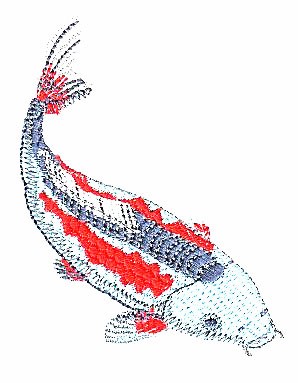
This lateral pattern is a very relevant fact and it will be critical in proper identification of some Doitsu Hariwake as compared to some other similar looking breeds.
Fork in the Road…The Sakura Ogon
So we know that a Hariwake is a metallic white based Koi in wagoi or doitsu versions that have this dorsal type pattern. However the original Hariwake was created by crossing a wagoi Kohaku (non metallic breed) to a wagoi Platinum Ogon (metallic breed). Back then the preferred offspring were a metallic white based fish with a red pattern. These fish at that time were called Sakura Ogon. Sakura translates to “cherry blossom” and was used because of the metallic red patterns. Since then however the Sakura Ogon was developed into other colors like orange and yellow, and these fish were called Hariwake. After this development all the wagoi offspring were called Hariwake even if they had red patterns from the Sakura Ogon. The name Sakura Ogon has pretty much been eliminated since the development of the wagoi Hariwake. However even today you would not be incorrect to call a wagoi Hariwake with a red pattern a Sakura Ogon.
The Wagoi Hariwake
Here are some photos to compare Wagoi (scaled) Hariwake to the Doitsu versions (see Figure 26 and Figure 27). You will see that I have listed multiple possible breed names for a few of these fish. However, please note that today you may not be incorrect to call some of these fish by either of the two names I have listed for them. Many people confuse these breeds because of this. Even some of the new-generation Japanese breeders have changed what they call them in some cases.
Figure 26 Wagoi Hariwake

Figure 27 Doitsu Hariwake
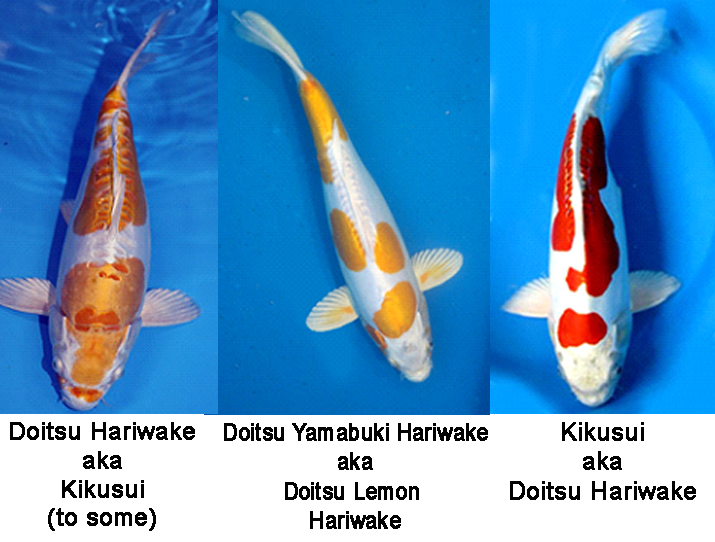
Understand that in some cases when breeding Koi, you can get to a final destination from different ways. This is exactly what happened in the development of the Hariwake variations. Hariwake were created by different breeders in different ways. Take a look at Figure 28 below to see how this was done;
Figure 28 Wagoi Hariwake and Doitsu Hariwake development.
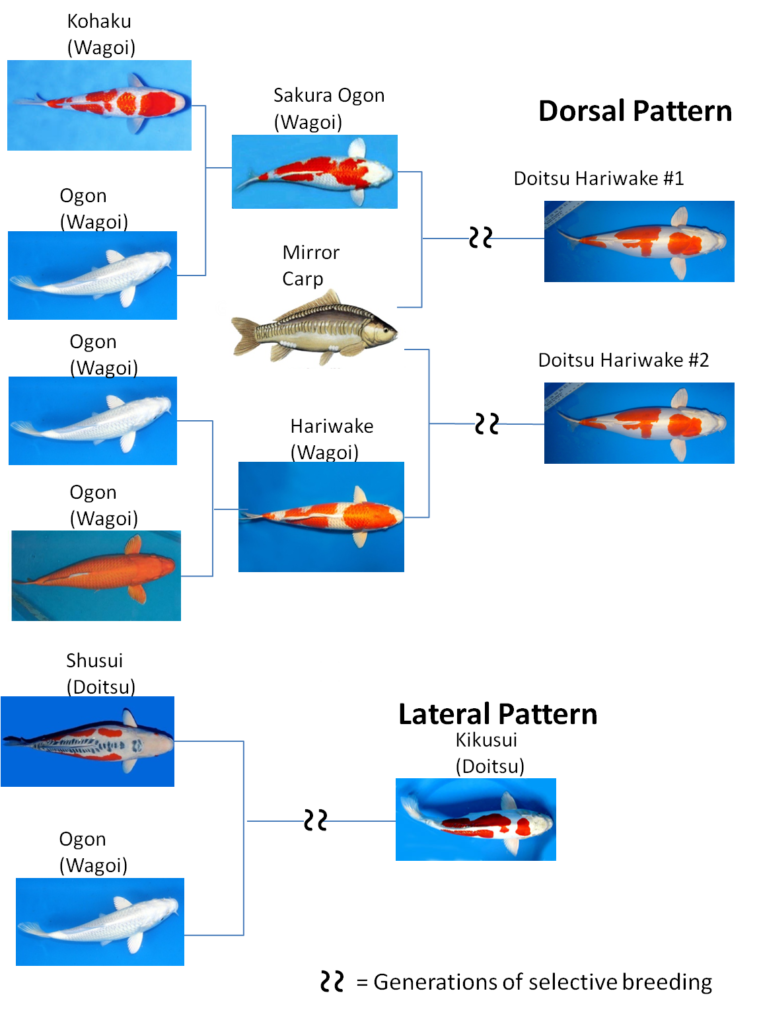
Wagoi Hariwake Development
You can see in Figure 28 that Sakura Ogon,(a wagoi) were created by crossing the Kohaku wagoi (non metallic breed) to the wagoi metallic breed Platinum Ogon. So this is a Kohaku to and Ogon pairing. The result was the Sakura Ogon wagoi. This was basically the first wagoi Hariwake, but the name Hariwake had not come to be yet.
However you can also see another way Hariwake wagoi were developed as well. In this case a breeder paired a wagoi Platinum Ogon to an Orenji (orange) Ogon. So in this case we have an Ogon to an Ogon pairing. This pairing produced less refined patterns in comparison , but it did produce the first true wagoi Hariwake. With further selective breedings over years, a more refined dorsal pattern of the Hariwake was achieved as well. As well, at some point in all of this, the Sakura Ogon was developed into other color variations besides red. Yellow and orange were the primary colors. This in turn is when the new name Hariwake came to be.
Doitsu Hariwake Development
As you can also see in the gene tree in Figure 28, the Doitsu Hariwake were also developed in different ways by different breeders.
Doitsu Hariwake #1 from Figure 28
As you can see in Figure 28 above, Doitsu Hariwake #1 was developed from a pairing of the wagoi Sakura Ogon to a Doitsugoi. In this case we show all the way back to the German Mirror carp.This was to get from the wagoi Hariwake to the Doitsu Hariwake. As a matter of fact it would add lots more years of selective breeding to go from the German Mirror carp all the way to the Doitsu Hariwake, but some breeders did. Most however started the Doitsu Hariwake line by crossing the Doitsu Platinum Ogon directly to the Sakura Ogon, and this greatly shortened the process to get to Hariwake.
Doitsu Hariwake #2 Development
The other way Doitsu Hariwake were developed is shown in the gene tree in Fig.28 as well. This Doitsu Hariwake was developed from the Ogon to Ogon pairing of the wagoi that produced Hariwake wagoi but with sloppy patterns of the two colors. Over time these patterns were refined to the proper dorsal Hariwake pattern. It was at this point in refinement that Hariwake wagoi was bred to the Doitsugoi or Doitsu Platinum to create Doitsu Hariwake #2
So we have Ogon to Kohaku to doitsugoi lineage to get to Doitsu Hariwake #1 and we have Ogon to Ogon to Doitsugoi lineage to produce Doitsu Hariwake #2
Are you with me so far? Now we get to the breed Kikusui.
The Kikusui
If you notice in the gene tree in Figure 28 at the bottom, there is one more lineage shown. This line of breeding lead to a breed called Kikusui. These also were a metallic white based doitsu Koi similar to a Doitsu Hariwake. Even though a Kikusui can look similar to a Doitsu Hariwake, being a metallic white-based fish with a pattern, it is not exactly. The primary difference is in the lineage and in the lateral type pattern of the Kikusui as compared to the dorsal pattern of the Doitsu Hariwake.
As you can see in Figure 28 above, Kikusui were developed by breeding an Ogon to a Shusui INSTEAD of going all the way back to the German Carp like was done with Doitsu Hariwake #1 and #2 in Figure 28. This is a critical fact. You need to have a Doitsu fish somewhere in the lineage to create another Doitsu fish. So here they used the Shusui to get to the Doitsu version .This Shusui blood IS what created this lateral pattern, and thus the genetically different Kikusui. It was also the Shusui blood that made most of these offspring red in pattern color. With this lineage, the offspring were called Kikusui because of the red colored wavy lateral pattern derived from the Shusui. So this is the original Kikusui by lineage and definition.
The Key Note
Basically put, the original Kikusui had a lateral pattern and most were originally red, and the Doitsu part came from Shusui. The Doitsu Hariwake had a dorsal pattern, and came in various colors of yellow, orange and shades of orange or red , and the Doitsu part came directly from the Doitsugoi/German Carp. So the Kikusui and the Doitsu Hariwake back then were two different breeds. Today however things have changed slightly. So as you can see, technically they are two different fish with different lineages.
Due to the above facts, we call a metallic Doitsu fish that has a base white color with a wavy lateral-type pattern in red or orange a Kikusui. The reason we limit it to those colors is because the name Kikusui literally translates to “floating flower or Chrysanthemum”, and that most of the original offspring in the Shusui to Ogon lineage were red or burnt orange when the name was created. So back then it started out that Kikusui were their own distinctive breed and named accordingly.
Once the Kikusui were developed and refined with the lateral patterns, the Japanese breeders started trying to create these fish with a more preferred dorsal type pattern like that of the ever popular Kohaku breed. This in turn lead to the development of the Doitsu Hariwake from yet another lineage. So now we have three ways that Doitsu Hariwake were developed? Sort of but let me explain further.

One More Catch
Today, 2020, you will not find many Kikusui or Doitsu Hariwake with lateral patterns. This is because the lateral patterns were being replaced with dorsal patterns. Remember the Japanese prefer the dorsal type pattern, and thus were slowly breeding out the lateral patterns. One way they did this is by breeding the Doitsu Kohaku to the Doitsu Platinum Ogon or Platinum Ogon. With this cross breeding they were getting both Kikusui and Doitsu Hariwake offspring. It was then that the breed names Kikusui and Doitsu Hariwake started to be confused and/or interchanged. This is because the resulting offspring had both lateral and dorsal patterns. However, most had dorsal type patterns from the Kohaku, and future breeding of those were to get rid of the lateral patterns. Even today there are still lateral patterns in some of the offspring that have the original genes of the Shusui in their line still. So basically put the Kikusui were developed from different pairings that lead to some of the same results in offspring. The difference today is that most breeders are only selectively breeding Doitsu Hariwake to Doitsu Hariwake to achieve the red patterns, and the lateral patterns are slowly disappearing. So now we have three colors of Doitsu Hariwake; orange, yellow, and red and mostly dorsal type patterns
Why We Should Discriminate Kikusui from Doitsu Hariwake
With the above information in mind, understand that the Japanese give most breeds a name that has something to do with describing the fish in some way. They want a name that creates a mental picture of what that fish generally looks like, and this is the primary reason that there needs to be a distinction between Kikusui and Doitsu Hariwake. To use a single breed name for all three color variations of these fish would not do this very well.
So today these fish with either a red pattern and/or a lateral pattern means it’s a Kikusui. Fish with Dorsal patterns other than red are technically Doitsu Hariwake. However it can be acceptable to call them all Doitsu Hariwake because most come from Doitsu Hariwake to Doitsu Hariwake spawnings today. There are very few breeders breeding true full blooded Kikusui anymore. However it would not be fitting to call them all Kikusui due to the mental picture desired. If you use the breed name Kikusui in 2020 it should be a Doitsu Hariwake with a lateral pattern of any color, or one that has a true red pattern whether lateral or dorsal. In this way there is at least a mental picture to separate the colors and pattern types. This is the key fact that many folks don’t understand.
The next series of photos in Figure 30 should help you to understand the difference between the Doitsu Hariwake and the Kikusui. Photos are much easier to grasp the difference as opposed to the written word. This is especially true when speaking of this author!
Figure 30…Dorsal Patterned Kikusui
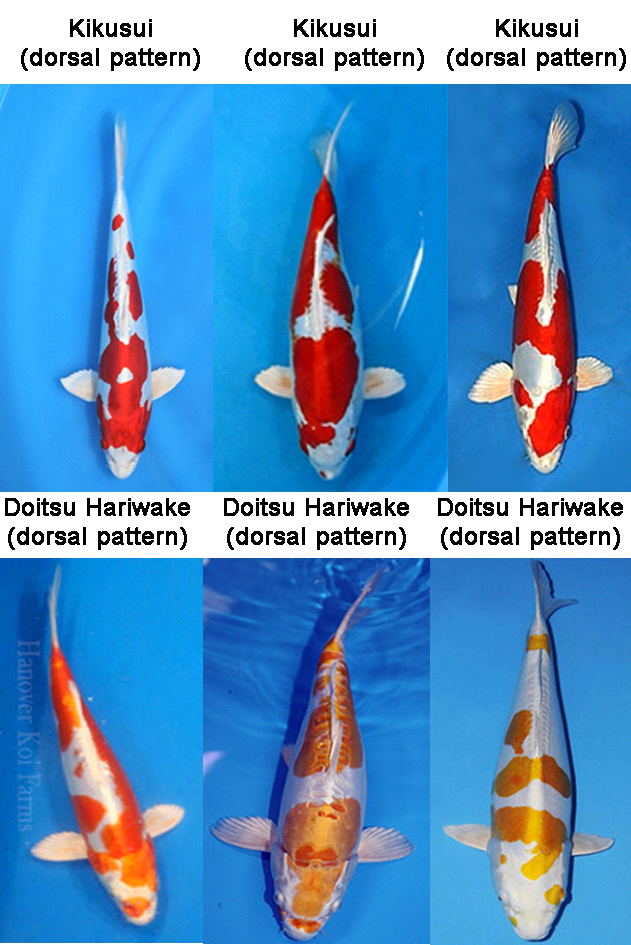
Once again understand that today, in modern times, you can get both Kikusui and Doitsu Hariwake from a single given breeding of Doitsu Hariwake to Doitsu Hariwake, or from Kikusui to Kikusui, or from Kikusui to Doitsu Hariwake. Just remember that a Kikusui (in today’s koi world) has a lateral pattern of any color, or a red dorsal pattern. The rest are considered Doitsu Hariwake no matter the color or pattern type.
In Summary
So we know for a fact that when Kikusui were created and named, it was primarily due to the lateral pattern that came from the Shusui lineage. It was the lateral pattern that defined a Kikusui originally and it still is today. However in today’s Koi world with this confusion it seems acceptable to call all of these fish Doitsu Hariwake no matter the pattern type or color. I feel however that you should still distinguish between the Kikusui and the Doitsu Hariwake due to the “mental picture” desired by the breed name. In this case, a Kikusui is a Doitsu Hariwake that has a lateral pattern and/or a pattern of red, but any color as long as it is in a lateral pattern. This because of the Shusui trait of the lateral pattern, and the original intent of the word “Kikusui”. Also, I feel that any true red Doitsu Hariwake should be called a Kikusui and not a Doitsu Hariwake, because of the lack of lateral patterned fish being bred today. So either call them all Doitsu Hariwake OR properly distinguish between Kikusui and Doitsu Hariwake by the lateral verses the dorsal patterns and/or the color red of the pattern. It would be incorrect however to call them all Kikusui. I hope this repetition of facts about the Kikusui verses the Doitsu Hariwake are not confusing you. I felt it was necessary to drive certain key point home. This is one of those sections that may warrant reading multiple times. However, I have simplified all of this information below in as simplistic a definition as possible in determining the difference between the Kikusui and the Doitsu Hariwake names.
Simplified Definitions
Kikusui Definition
A Doitsu Hariwake with any color lateral pattern or A Doitsu Hariwake with a red pattern of the lateral OR the dorsal type.
Doitsu Hariwake Definition
A Doitsu Hariwake with a dorsal pattern of orange, yellow, or any other color other than red.
Thank Heaven that’s done huh?
Moving On
Fish #6 in Figure 1 is called a Kikokuryu
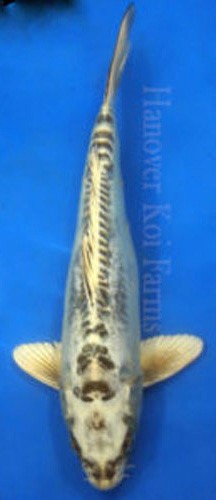
Kikokuryu (key-ko-koo-roo) or (key-ko-koo-loo) as the Japanese pronounce
If you thought the Hariwake were confusing, just wait until you learn about the Kikokuryu and its variations! The Kikokuryu is always a Doitsu Koi. A scaled Kikokuryu is considered a different breed, called a Ginga. We discussed Ginga a little in the Matsuba section of this article.
Both the Ginga and the Kikokuryu have what I refer to as ” Henka “(changing) sumi (black). We also touched on this in that previous Matsuba/Ginga section.
Henka is a word I use personally from the Japanese language because I know of no special classification for this type of changing sumi. (that doesn’t mean there isn’t one, but I don’t know of any).
Henka Sumi Explained
What this means is both the Kikokuryu and the Ginga have black that lightens and darkens (back & forth) based on variables like water temperature, lighting, background color of the system they are housed in, and even water chemistry. Water temperature is the one that has the most noticeable and immediate influence on them, however. In cooler water the Henka sumi will darken, and in warmer water it will lighten. At times they will change so drastically they are almost unrecognizable as the same fish! This holds true for both the Ginga and the Kikokuryu. Even the “white bucket” trick will cause some Kikokuryu to change before your eyes when they are in their dark phase. They will lighten within minutes. With some, you put them in a white bucket or tub and anywhere from a few minutes to a half hour later they will be in their light phase. This particular change in the Henka sumi is caused by the white background color they are in: the white bucket. Other Kikokuryu may not change this quickly and take a period of days or weeks to do so.
Look at the Figure 32 below for examples of how these fish can change! Understand that the two photos of the Ginga are the same fish, and the two photos of the Kikokuryu are the same fish! This is how extreme the change can be at times. This change is due to the fact that both the Ginga and the Kikokuryu were originally created from the Doitsu breed called Kumonryu. The Kumonryu is the breed that created Henka sumi. So, we need to discuss this breed as well for a complete understanding of Ginga and Kikokuryu.
Figure 32 Tone Phases of Ginga & Kikokuryu
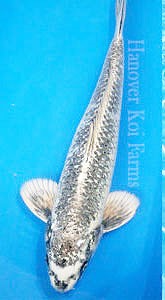
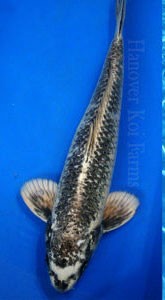
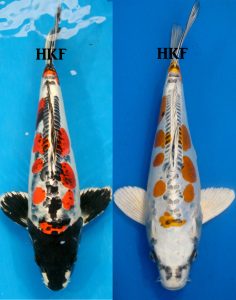
Figure 32: Both the Ginga (top) and the Kikokuryu (bottom) are characterized by the Henka sumi that constantly changes back and forth between a light phase and a dark phase, and everything in between. Kikokuryu is the proper name for a Doitsu Ginga. As previously mentioned, these two breeds were developed from another breed called the Kumonryu. So let’s talk a little about them.
Kumonryu
(koo-mun-roo) or (ku-mun-loo) as the Japanese pronounce)
The Japanese word Kumonryu translates to “nine crested dragon” In Japanese folklore this dragon named Kumonryu was able to change colors and pattern as it flew into and out of the clouds in the sky so it could stay hidden from its enemies.
Kumonryu were originally developed by selective breeding of Doitsu Yotsushiro. They also have a Doitsu Karasugoi lineage further back in the line as well. Karasugoi are simply all black Koi in wagoi or doitsu versions. Karasu simply means “black crow”.
Kumonryu are always a Doitsu breed that is white-based, non-metallic Koi with a black pattern from the Karasugoi lineage. It is with Kumonryu that Henka sumi was born. Since it is a white-based fish, it is the Henka sumi that changes in both pattern shape as well as in the intensity of the sumi. This changing of sumi tone as well as the change in pattern shape is what defines a Kumonryu. There is also a Beni Kumonryu sub breed that has red added by breeding to a Doitsu Kohaku,(and sometimes Shusui) but they don’t have much relevance in this article. The red color remains stable and does not change like the Henka sumi.
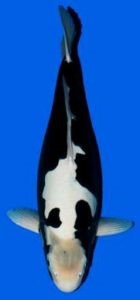

Figure 33: examples of the Kumonryu and the Beni Kumonryu: the predecessor to the Kikokuryu.
Differences in Henka Sumi
The Henka sumi of the Kumonryu does not change for as many reasons as the Henka sumi of its cousin the Kikokuryu. Kumonryu do have predictable pattern changes with water temperature and the background color of the system they are housed in, but they seem to change even more so for no apparent reason. One day they can be black and white and be patterned Orca whales, and as soon as a week later they can be all black. Then they may change to all white and every combination of white and black in between, and for no dicernable reason. They are not a fish to acquire for what they look like at the time of purchase. This is because they will change. How often, and how much they change has lots of variables and unknowns. Quite often they will change back and forth for a period of years, then at some point in maturity they stop changing and stay whatever they were at that time. So this Henka sumi that originated with the non-metallic Kumonryu was bred into the metallic breed Kikokuryu when they used Kikusui as one of the parent stock combined with the Kumonryu. We will discuss this in detail shortly. Just know for now that the Kumonryu is a fish to purchase for the fascination of how it changes and not what it currently looks like!
Kikokuryu was an Unexpected Child
Once the Kikokuryu was developed from the Kumonryu it really made a hit in the Koi world, and including with me! They were actually accidentally created in 1993 when a Japanese breeder, Mr. Haruo Aoki mixed in a Kikusui to a Kumonryu spawn. He was breeding Kikusui in one pond and Kumonryu in another pond. The Kikusui finished spawning first, but the males of the Kikusui were still chasing the female. In the Kumonryu pond they had not spawned yet, so it was at this point that the breeder took a couple of the Kikusui males from the other pond and put them into the pond of the breeding Kumonryu to help get them going better since the Kikusui were already in the mood! As the offspring of this last second pairing grew, the breeder was in total shock at what he produced. This was the beginning of a new breed of Koi, the Kikokuryu, (as well as a sub–breed, called a Beni Kikokuryu which we will discuss later on.)
Figure 34 below shows what those first Kikokuryu looked like most likely. There were basically a metallic version of the Kumonryu but with more predictable changes in the sumi compared to the Kumonryu. Kikokuryu translates to “shiny black dragon”.
Figure 34 Finished/Mature Kikokuryu (in their dark phase)
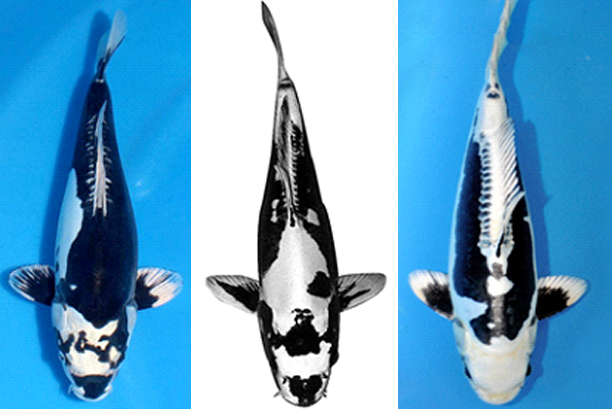
“Finished” & “Unfinished” Kikokuryu
Notice that in Figure 34, I call these “Finished” Kikokuryu. This is because the Henka sumi can start out either on the surface as what looks like a “dusting” of black or pewter-colored powder. Alternatively, it can appear as black underneath the white base color and this is quite common in young Kikokuryu. When the Henka sumi starts below the surface of the white on a younger Kikokuryu, they will appear to have a blue tint to the white base color, but they are not truly blue at all. They are only bluish temporarily however. These are “unfinished” Kikokuryu. The blue look is actually the Henka sumi/black which is under the white skin. This gives a blue look as the white dilutes the shade of black and gives it the illusion of being blue. Over time that black under the white will rise to the surface and look like a normal Kikokuryu: black and white. It is at that point they are considered “finished” Kikokuryu. Here is an example of a young Kikokuryu where the black has not risen to the surface yet, note the overall blue tint to the body;
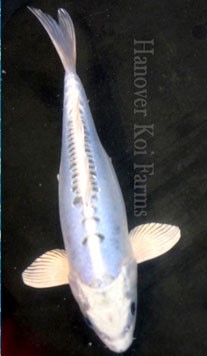
Kikokuryu Misidentification
This young blue-tinted fish is mistakenly called a Blue Kikokuryu, a Blue Doitsu Matsuba, and even Doitsu Gin Matsuba by many Koi dealers out there. They are incorrect. Firstly, there is no such breeds as a “Blue Matsuba” or “Blue Kikokuryu”. If you look closely at the photo of the Kikokuryu with the blue tint in Figure 35, you can see the Henka sumi starting to rise to the surface on the right side of the photo (left side of fish) behind the head. Exactly when this sumi will fully rise is variable. Some can appear blue for a few years even, but eventually it will rise to the surface as the black it truly is. This is what makes them a Kikokuryu and NOT a Blue Matsuba nor a Blue Kikokuryu, as the blue will become black as it finishes. They surely are not Gin Matsuba either! Here is another example of Henka sumi and the difference between Kikokuryu and the other breeds mentioned, like the Doitsu Gin Matsuba.

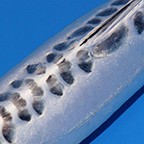
Figure 36: The “dusting” of Henka Sumi is present in Kikokuryu (left) but not in Doitsu Gin Matsuba (right)
So, when you see this “dusting” of Henka sumi you know the fish is a Kikokuryu, or at minimum it has Kikokuryu blood in it. As well it will temporarily lighten and darken accordingly as previously discussed. The other breeds that are not Kikokuryu, but look similar, will not have this Henka sumi. Also, in younger Kikokuryu this Henka sumi might not be easy to see at times and requires the white bucket trick or very close examination of the skin on the sides of the Koi.
In Figure WB2 below you can see another example of how the white bucket trick really works. Understand that these two photo are of the same fish, and they were taken a few minutes apart. The only difference is one photo is the fish in the standard blue viewing tub, and the other is in the white bucket.
Figure WB2 This is the exact same fish! In the photo on the left the fish looks like a Doitsu Platinum Ogon. However when you see the same fish in the white bucket in the photo on the right, you can easily see it is actually a young Kikokuryu, as evidenced by the black in the dorsal scales and the blue tint of the skin on the top sides of the fish. That blue tint is actually sumi (black) that is submerged below the upper layer white skin. Over time that underlying black will rise to the surface and end up on top of the white skin.
-

Young Kikokuryu that looks like a Doitsu Platinum Ogon -

The white bucket trick proves it is NOT a Doitsu Platinum Ogon and clearly shows it as a Kikokuryu
Understand that this “finished” and unfinished” is more of a maturity change. This is not the same thing as how the Henka sumi of the Kikokuryu temporarily lightens and darkens. This temporary change is more like that of a chameleon change and has more to do with camouflage when speaking of going from a dark background of a pond to the light background of a white bucket or lighter container.
With younger Kikokuryu, once the Henka sumi rises to the surface they are considered “finished”. However, after they finish you will see the “temporary ” changing of the Henka sumi from light to dark as previously discussed. This is the “phase” of Henka sumi. Basically, it depends on the age and size of the fish as to how it will change and how long it will stay that way, and the “phase” that dictates how light or dark the Henka sumi is on a finished kikokuryu.
Below is an example of how a “Finished” Kikokuryu will change from the light to the dark “phase” and vice versa based on those previously mentioned variables. This happens on mature or finished Kikokuryu primarily.

The Kikokuryu on the left is in its dark phase and is the same fish as the one on the right when in its light phase.
Henka Sumi in Young Kikokuryu
As mentioned, the Henka sumi in young Kikokuryu can be difficult to see at times. This “dusting” of pewter-colored Henka can be sparse and very light in color. Here is Henka sumi in a young /unfinished” Kikokuryu Butterfly (see Figure 38). You can barely see the pewter-colored Henka sumi mixed within the white skin. Many people would misidentify this fish as a Doitsu Platinum Ogon or a Doitsu Gin Matsuba.
Figure 38 Henka Sumi of immature Kikokuryu
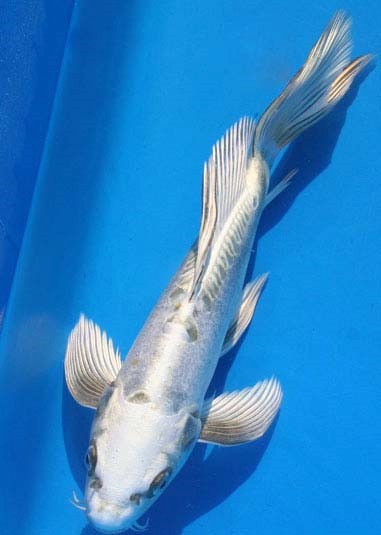
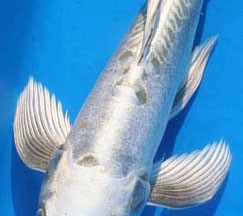
Figure 38: some examples of Henka Sumi in a young, immature Butterfly Kikokuryu. Notice the light dusting of Henka Sumi which gives the fish a light pewter color.
Kikokuryu Summary
We have learned that some young Kikokuryu can appear blue in color when they have submerged Henka sumi, and others instead have a very light dusting of Henka when immature and unfinished. At some point the black will intensify and you will see the beautiful black and white Kikokuryu, but depending on the other variables that make them change sumi tone phases. Just how black they get depends on these variables. The most common and noticeable change from light to dark phase will occur in the fall of the year and into winter as the water cools. This is when they will become their darkest phase and the Henka sumi will turn inky black in many cases. Then, as spring and summer come and the water warms, they will revert back to their light phases and the Henka sumi subsides to create their lighter phase. But remember that certain unknown water chemistry can also cause this change regardless of water temperature. Also, if the fish are housed in dark or light-colored tanks and such, this can also cause them to lighten and darken to extremes on a temporary basis while in these systems.
Sub-Breeds of Kikokuryu
As previously mentioned, when Kikokuryu were accidentally created, some Beni Kikokuryu were also created in the same spawning. These were Kikokuryu with a red or orange pattern. When the Kikusui males (metallic fish) bred with the non-metallic Kumonryu female, the resulting offspring were both Kikokuryu and Beni Kikokuryu. A Beni Kikokuryu is simply a Kikokuryu but with an orange or red pattern mixed in with the black and white of the Kikokuryu. This leads us to fish #7 in photo 1 (see Figure 39)
Figure 39 Fish #7 from Figure 1 Photo
Beni Kikokuryu
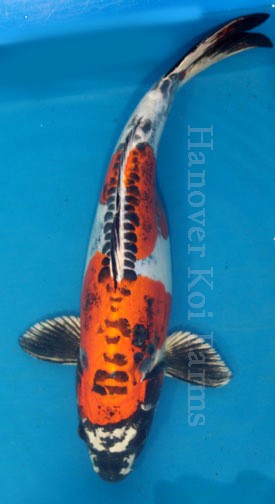
Fish #7 from Photo 1 is a Beni Kikokuryu
Beni Kikokuryu
So we have learned one way Beni Kikokuryu were created with the Kikusui to Kumonryu pairing. You can see this in in the gene tree (Figure 40). Later on, however, they were created again, separately, by breeding Kikokuryu to Kohaku, and even Shusui. Once again, this is an example of how we can get to a single breed from multiple directions. There are almost endless pattern designs and colors you can achieve with this very versatile breed depending on what they are paired with.
Today there are many different bloodlines of Beni Kikokuryu, and they are all very striking and unique fish. This is one reason they are so popular with American Koi hobbyists. The Kikokuryu and all of its sub-breeds are also a signature breed here at Hanover Koi Farms, and to date we have our own world class lineage. Here are a few we have produced in Figure 40 below;
Figure 40 Beni kikokuryu bred by Hanover Koi Farms
Figure 40 Beni Kikokuryu bred by Hanover Koi Farms
Misidentification of Beni Kikokuryu
Beni Kikokuryu are commonly mixed up with the breed called Doitsu Kujaku as well as another breed called Kin Kikokuryu. Kin Kikokuryu is another sub breed of Kikokuryu that we will discuss shortly. Once again, many dealers out there simply do not understand the differences between these breeds. As for mistaking Doitsu Kujaku with Beni Kikokuryu, and even some Kin Kikokuryu, guess what the primary difference is, other than the actual lineages? You guessed it: It is primarily the Henka sumi, as well as a few other noticeable differences. These three different breeds of Koi come from very different lineages (See Figure 41 below. ). The Doitsu Kujaku has a Doitsugoi lineage and further down the line a Gin Matsuba by Kohaku lineage, and the Beni Kikokuryu has a Kumonryu by Kikusui/Shusui lineage. So you can see these fish are not related other than the fact that they come from the original Doitsugoi. Therefore, the Doitsu Kujaku does not possess the Henka sumi like the Kikokuryu or Kin Kikokuryu. For now, we will compare how the Doitsu Kujaku and the Beni Kikokuryu are different, since these are more often confused with each other. Then we will get to the difference as well between these two breeds as compared to the Kin Kikokuryu, as there are times when all three can be confused with each other.
Figure 41 Kikokuryu, Kin Kikokuryu and Doitsu Kujaku Genetics

Figure 42 Doitsu Kujaku compared to Beni Kikokuryu.
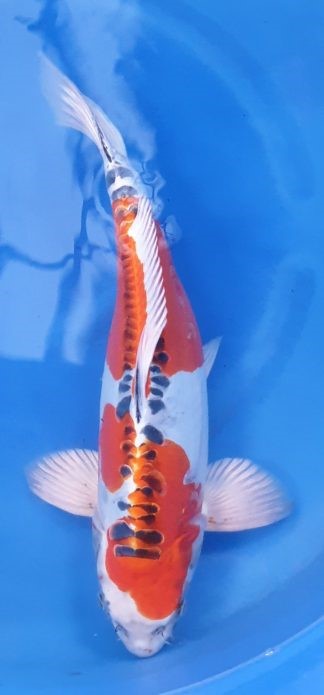
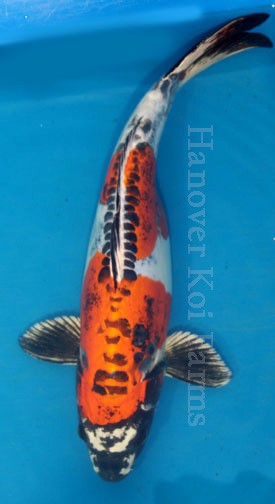
Figure 42: a side by side comparison of a Doitsu Kujaku and a Beni Kikokuryu You should be able to see noticeable differences between them . Figure 43 below gives some details as to these differences
Figure 43 Details of the Beni kikokuryu
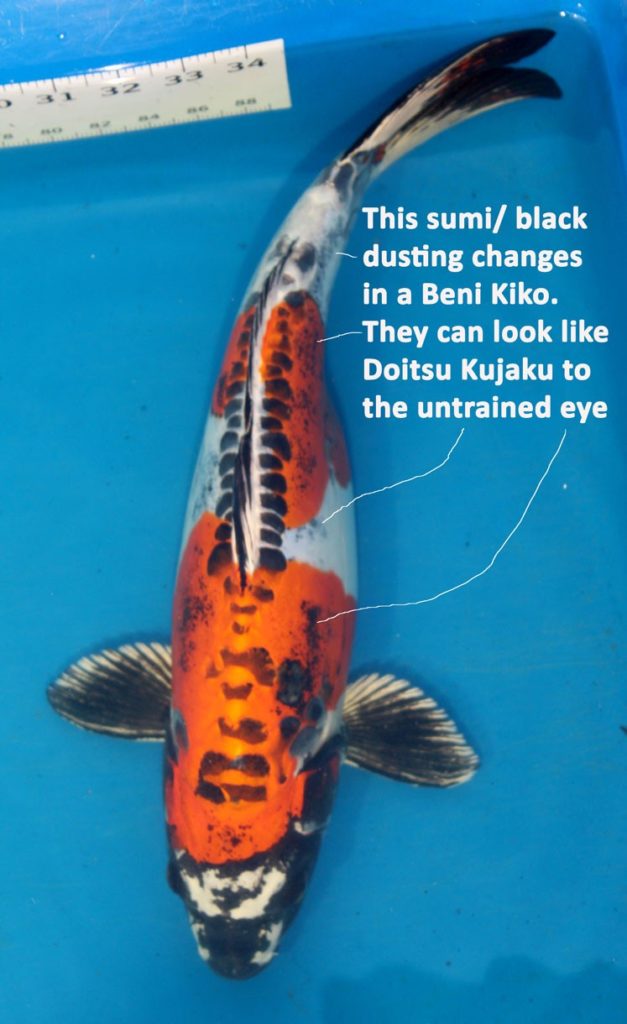
You can clearly see that the Doitsu Kujaku in Figure 42 has no Henka sumi, and it normally has white fins instead of black like the Beni Kikokuryu. Lower grade Doitsu Kujaku can have black in the fins as well as some sumi on its sides. However, any sumi on the sides of a Doitsu Kujaku is NOT Henka sumi, and therefore it will not change or lighten and darken as with the sumi of the Beni Kikokuryu. Here are more comparison photos in Figure 44 and Figure 45 to help you see these differences: Note the color of the fins, the lack of Henka sumi, and the lack of any other black (other than the black Doitsu scales down the back) on the Doitsu Kujaku as compared to the Beni Kikokuryu;
Figure 44 Doitsu Kujaku
Figure 45 Beni Kikokuryu
Doitsu Kujaku & Beni Kikokuryu Summary
We know by lineage that Doitsu Kujaku and Beni Kikokuryu are completely different breeds, but they can appear similar at first glance. If you look closely at the previous comparison photos, you can see the Henka sumi is not present in a Doitsu Kujaku and is present in the Beni Kikokuryu. Also, most Doitsu Kujaku will not have black fins (although some can). They will have white fins. The white in a Doitsu Kujaku’s skin is much cleaner and usually whiter when compared to the Beni Kikokuryu.
You can expect the Henka sumi in the Beni Kikokuryu to lighten and darken back and forth based on the previously mentioned variables like water temperature. In the light phase, any white showing will be an off-white usually with some amount of Henka sumi showing. The black of the Doitsu Kujaku will not change because its sumi is different from Henka sumi. So it is a combination of factors involved here to discriminate between the two breeds.
Other Considerations
Now you still must understand that viewing these fish when young can also cause more confusion as compared to when they are finished maturing. More importantly than the age, the quality or grade of the individual can also cause confusion, as a low grade Doitsu Kujaku, or simply ones that have some faults, may look more like a Beni Kikokuryu. In Figure 46 you can see some comparison photos of lower quality specimens of each;
Figure 46 Lower Quality/Grade Doitsu Kujaku
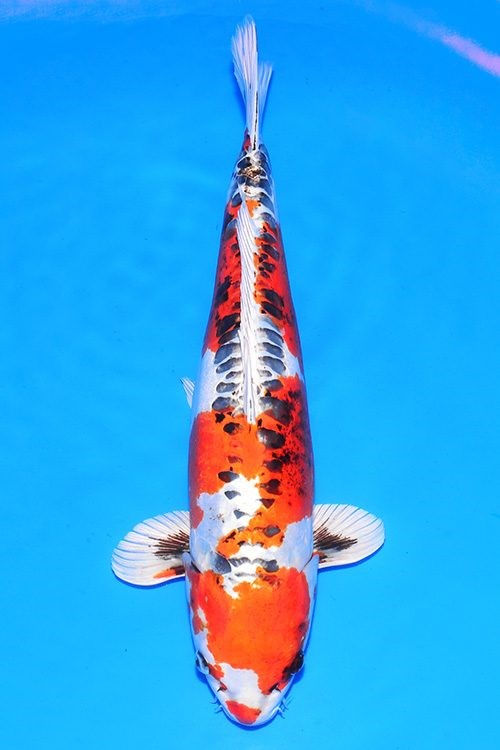
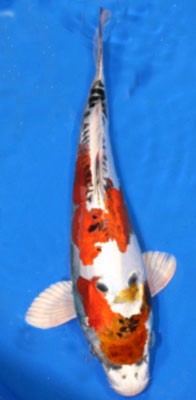
Figure 46: Examples of Doitsu Kujaku with Faults/ imperfections
Quality Comparison
Notice the black spots (sumi) on these lower quality Doitsu Kujaku in Figure 46. This is not Henka sumi. It is regular sumi and it will not change other than growing in size as the fish grows. It will not change like Henka sumi which will temporarily lighten and darken. These are simply black sumi spots (not Henka Sumi) and are considered faults/blemishes on a Doitsu Kujaku. So do not be confused by Doitsu Kujaku that have some faults when comparing them to Beni Kikokuryu. Upon close inspection you should be able to see the difference in the two types of sumi.
You can also see some black, as well as orange, in the fins of the fish on the left above. This is yet another fault in a Doitsu Kujaku. The fins are still primarily white which is more evidence that this fish is simply a Doitsu Kujaku with faults and not a Beni Kikokuryu, which often have more black in the fins
Fig. 47 Written Comparison between Doitsu Kujaku & Beni Kikokuryu
As you can see below you have to use a combination of these variables to decide which breed they may be;
| Doitsu Kujaku | Beni Kikokuryu |
| Clean white on body | Dirty white & Henka sumi |
| White fins | Fins can be white or black |
| No Henka sumi | Henka sumi (light or dark phase) |
| No black on head (unless faulty) | Usually black on head |
| Only black scales | Black scales plus Henka sumi on body |
| Black that Won’t change | Black that Will change |
At this point we need to discuss the other sub breed of the Kikokuryu. as this is the next fish to be identified from Figure 1 photos.
Figure 48 Kin Kikokuryu
Fish #8 from Figure 1 is a Kin Kikokuryu

Kin Kikokuryu
Before we get back to the comparison of these Kikokuryu breeds we need to discuss the Kin Kikokuryu and its development, lineage, and varied looks. The Kin Kikokuryu is the newest off-shoot of the three breeds we are discussing here. The other two being the Kikokuryu and the Beni Kikokuryu.
The development of Kin Kikokuryu is accredited to a Japanese breeder by the name of Seiki Ikarashi, and it was introduced to the Koi world at the 2000 All Japan Koi Show. Basically put, the original Kin Kikokuryu was a Kikokuryu with a yellow pattern added to it. Also, the Henka sumi tended to be more of a shiny pewter color as opposed to a flat sumi color, or black “dusting” of the Kikokuryu and Beni Kikokuryu. Mr. Ikarashi used a female Doitsu Kin Showa paired with male Kumonryu and Shusui to create the first Kin Kikokuryu (see Figure 41 above. Kikokuryu gene tree). The very first offspring had a yellow pattern, and this was the beginning of the new breed. So, initially it was the “yellow” pattern that distinguished the Kin Kikokuryu from the other Kikokuryu sub breeds. However, in Japan the categorization goes much deeper than that. As a matter of fact, in Japanese Koi shows, the Kin Kikokuryu is categorized into four different, and supposedly, distinct groups. However, to this day I have never had anyone, Japanese or otherwise, explain these subtle variations in a way I can understand. Frankly I don’t see many big differences between these groups/variations, and personally feel this is an unneeded confusion. Also it only seems applicable to the world of Showing Koi. There is another reason I feel this way as well, and it involves a side note.
The Side Note
Back in the year 2000, I was also experimenting with Kikokuryu and Beni Kikokuryu in an attempt to get a yellow pattern onto the Kikokuryu. However at that time I had no knowledge that anyone else was attempting it, much less that Mr. Ikarashi had already done it. When I first got a stable yellow pattern onto the Kikokuryu, I named the breed Ki Kikokuryu. Then, I think it was in 2001 or 2002 that I saw an article in a Koi magazine about this “new breed” of Koi called the Kin Kikokuryu! Upon reading the article about Mr. Ikarashi and his development of the Kin Kikokuryu in the late 1990’s, I was shocked to see I had created a very similar look in my Ki Kikokuryu and its variations. So, it was then that I decided my creations were to be called Kin Kikokuryu in honor of Mr. Ikarashi and out of respect for the Japanese forefathers of Koi.
Kin Kikokuryu Variations
Once I tried to understand all the variations of what the Japanese called Kin Kikokuryu is when I decided that this was not needed with my bloodline of Kin Kikokuryu. Once again, the basic difference between the original Kin Kikokuryu and a Beni Kikokuryu is the pattern on the Kin Kikokuryu is Yellow or gold, instead of the orange or red pattern of the Beni Kikokuryu. Another big difference is in the Henka sumi of the Kin Kikokuryu. It has a more shiny pewter appearance on most or all of the body due to the Karasugoi lineage. In this case the pattern can be orange or red as well and it is still considered a Kin Kikokuryu due to this more abundant and darker Henka sumi. Even in the light phase, a Kin Kikokuryu’s Henka sumi will be darker overall and more gray pewter in color.
So we will not get into how the Japanese separate these Kin Kikokuryu into 4 or even 5 groups if you count the Momiji. Instead I am basing this information on my own experiences in creating this new breed, which was accidentally the same as how Mr. Ikarashi did it. Take a look at the next photos of variations of HKF Kin Kikokuryu 1- 4 in Figure 47 below;
Figure 47 Kin Kikokuryu Variations by HKF
KIn Kikokuryu #1 is one variation of the Kin Kikokuryu. Notice the yellow pattern as compared to the orange or red of the Beni Kikokuryu. You can also see the substantial black in the fins and the black on the head, and this is why it is not a Doitsu Kujaku. So with all of this we have one variation of the Kin Kikokuryu. This variation of Kin Kikokuryu does not have much Henka sumi, but it is there. This fish will lighten and darken because of this Henka sumi, but it will never be very pronounced.
Kin Kikokuryu #2 also has a yellow pattern with less black in the fins. It is the yellow pattern that makes this a Kin Kikokuryu. However, you can easily see the Henka sumi on the sides of the body as well, and this fact also makes it a Kin Kikokuryu. With this type of Henka sumi this fish will greatly change in appearance from light phase to dark phase.
Kin Kikokuryu #3 This variation of the Kin Kikokuryu happens to be orange. It is the shade and the amount of Henka sumi that makes this a Kin Kikokuryu. This particular photo is the fish in its light phase. Once it darkens into its dark phase, it becomes like fish #4 above.
Kin Kikokuryu #4 is simply a Kin Kikokuryu in its dark phase. In its light phase it looked very similar to fish #3. Once again it is the amount of Henka sumi that makes this a Kin Kikokuryu
Misidentification of Beni Kikokuryu and Kin Kikokuryu with Other Breeds
One other way Beni Kiko and Kin Kiko are commonly misidentified is with the Doitsu Kin and the Doitsu Ki Matsuba. Once again, the common mistake is the difference in the Henka sumi. The Doitsu Matsuba do not have this Henka sumi as previously mentioned.
Understand that when breeding both the Beni Kiko and the Kin Kiko, there will always be some offspring that lack a defined orange, red, or yellow pattern on a black and white base. Instead almost the entire fish is orange, red or yellow with little or no visible white. Mixed within these solid colors you will still have the Henka sumi. Here at HKF, we jokingly refer to these lower grade Beni and Kin Kiko as “Full Monty” Kiko’s. Even though they are considered a lower grade than a properly patterned Kiko, they can still be quite striking in appearance. For this reason, we do keep and sell some of the better ones. In Figure 48 below are some examples of “Full Monty” Beni and Kin Kikokuryu as compared to the Kin and Ki Matsuba Doitsu they are commonly mistaken for and vice versa;
Figure 48 Some Low Grade yet still attractive “Full Monty” Beni Kikokuryu and Kin Kikokuryu
NOTE the Henka sumi that will lighten and darken temporarily
as compared to the high grade young Doitsu Kin Matsuba below
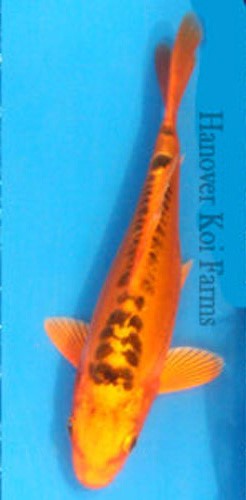
Figure 49 More Lower grade yet unique & attractive Kin Kikokuryu

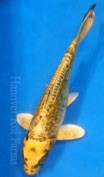

Note the Henka sumi in figure 49 above as compared to the Young high grade Doitsu Ki Matsuba below in Figure 50
Figure 50 Young Doitsu Ki Matsuba
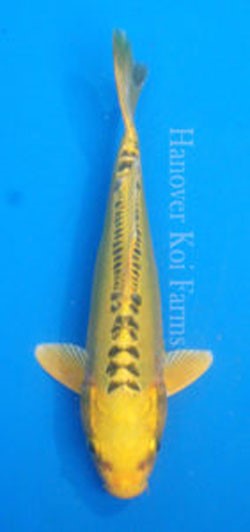
Once again no Henka sumi in this Doitsu Ki Matsuba
Figure 51 Some Kin Kiko’s can even look Green!

This Kin Kikokuryu appears green, but this is just the Henka sumi in this young Kin Kikokuryu that is still below the surface of the orange. It will rise eventually and no longer look green. It will eventually change to inky black and then change back and forth from light phase to dark phase as well after it matures.
A Few New Kin Kikokuryu Being Developed by HKF
Here at Hanover Koi Farms we are also developing two new breeds of Kin Kikokuryu, so these are exclusive to HKF! I cannot give details as to their lineage because they are currently works-in-progress and that’s proprietary information. However, I can show you some of our results to date in Figure 52 and Figure 53 below.
Figure 52 Mottled Kin Kikokuryu developed exclusively by HKF
Figure 53 Burnt Mottled Kin Kikokuryu


These two new variations of Kin Kikokuryu are creations of Hanover Koi Farms, and still in the development stages. We expect to have them stable in another two years tops. You will see fish that look similar to the one above on the right that are called “Doitsu metallic Ochiba”, but these have a different lineage all together.
So, this is all of the sub-varieties of the basic Kikokuryu. Here is the gene tree duplicated from Figure 41 to show you how these variations were created, minus the two new variations of the Kin Kikokuryu still in development at HKF. Understand that this is a very simplified lineage tree and there was much more selective breeding over years involved to get to these end products.
Figure 54 Kikokuryu Gene Tree

Now we can return back to identifying the breeds from Figure one photos and the next fish in line Fish #9
Fish #9 from Figure 1 is a Doitsu Kujaku
Figure 55 Doitsu Kujaku
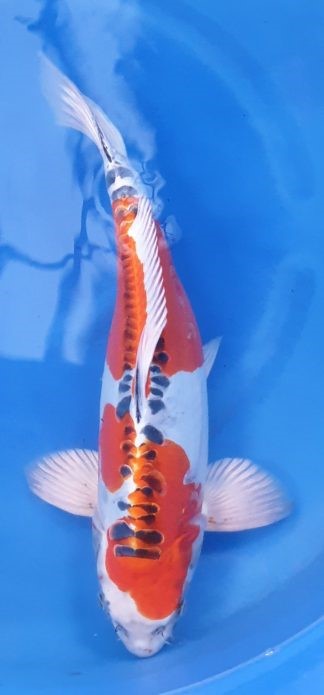
Doitsu Kujaku
We have touched upon the Doitsu Kujaku in the Beni Kikokuryu section, so you should understand now how to tell them apart. However, below in Figure 56 I have included more photos to better help you understand the differences. Once again it is the Henka sumi or lack thereof that distinguishes a Doitsu Kujaku from a Beni Kikokuryu.
Figure 56 Kujaku come in a Wagoi version as well as the Doitsu version.


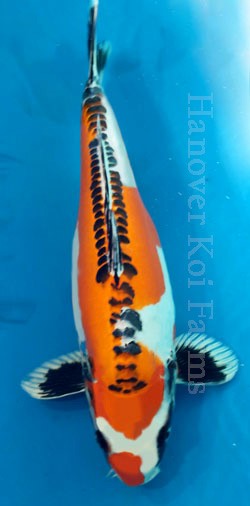
Since this Wagoi Kujaku breed is not directly a part of this article we will not discuss it any further at this time. For now, you can begin to see how the Wagoi and the Doitsu versions compare in Figure 56. This comparison is very similar to how the Matsuba Wagoi compare to the Matsuba Doitsu, however with the addition of a dorsal pattern.
Doitsu Kujaku generally have white pectoral fins. However, some can have black in the pec fins like the one shown. This is one of our own Doitsu Kujaku and we like the black and actually breed for it. This is our own lineage of Doitsu Kujaku. Just understand that there is not supposed to be black in the pectoral fins of most Doitsu Kujaku. This is yet another way to distinguish most Doitsu Kujaku from Beni Kikokuryu, as most Beni Kiko will have black in the fins and tail, while most Doitsu Kujaku will not.
As previously stated: the Doitsu Kujaku is commonly mistaken for the Beni Kikokuryu, but they are two very different breeds of Koi by lineage.
With that said this leads us to the final fish #10 from Figure 1 shown below in Figure 57
Figure 57. Doitsu Ki Kujaku Fish #10 from Figure 1
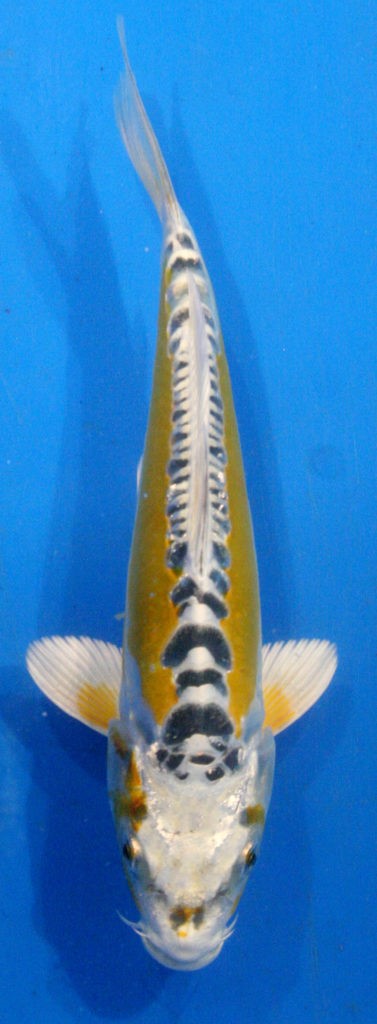
Fish #10 from Figure 1 photos is a Doitsu Ki Kujaku. This is a new breed that is being developed by Hanover Koi Farms, and other breeders in Japan. The name Ki Kujaku simply means a yellow metallic Doitsu Kujaku, and thus the name makes it self explanatory as a breed.
Figure 58 More Doitsu Ki Kujaku bred by Hanover Koi Farms
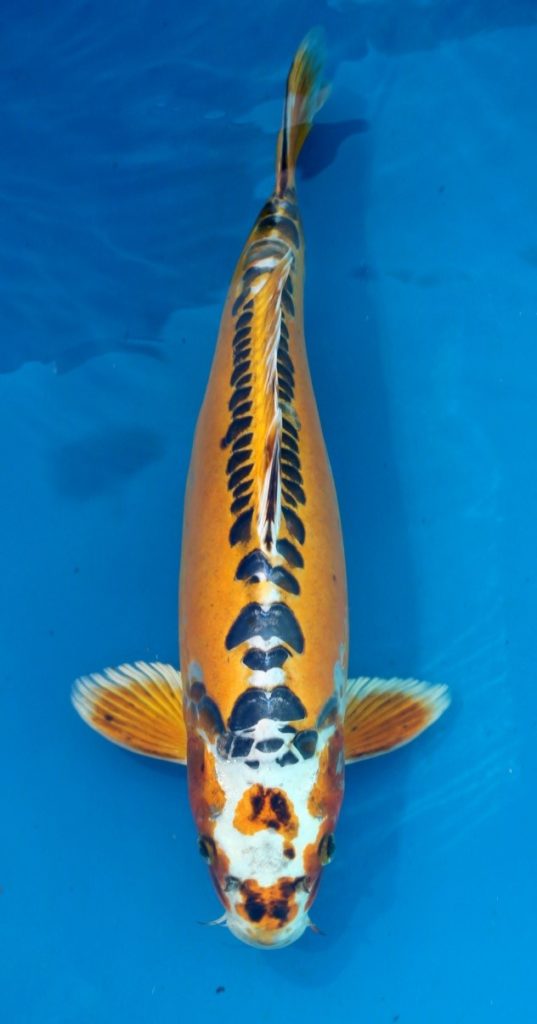
Mature/ Finished
Ki Kujaku
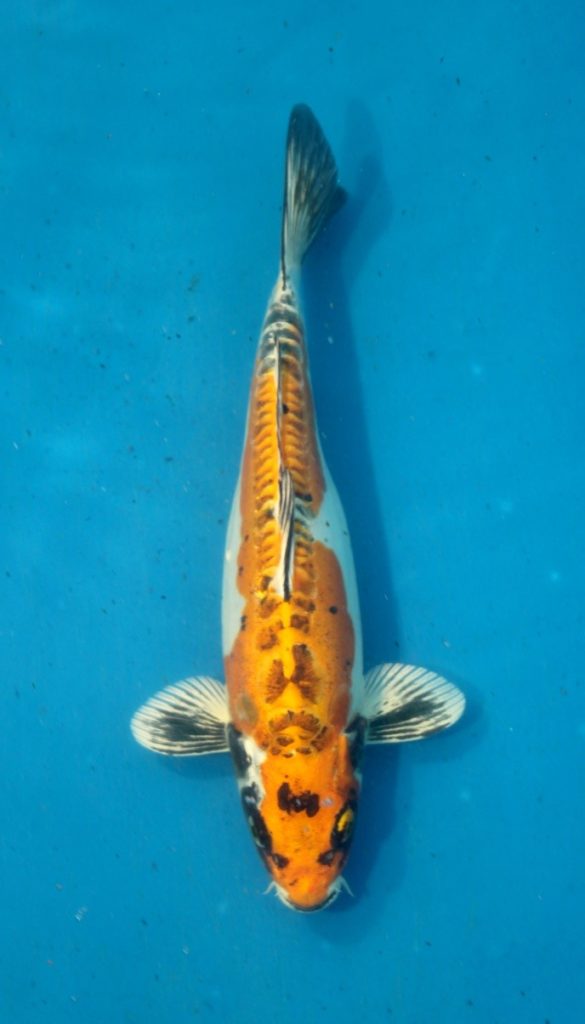
Ki Kujaku
Figure 58: An example of a finished and and unfinished Doitsu Ki Kujaku
Currently, this new breed of Doitsu Kujaku is a work in progress, and I cannot give any more details at this time as it is proprietary information.
In closing I hope this very difficult article to write was still able to help you learn how to better identify some of these breeds of Koi and their variations. After all, no one realizes more than I that I am a Koi breeder and NOT a writer!
I hope as well that some of the Koi dealers out there read this article, because I cringe every time I see a misidentified Koi LOL! I can say that if you come to Hanover Koi Farms, we can show you and tell you on the spot with live fish, how to properly identify them! You can also see the “white bucket” trick in action! This will be far less confusing than this article may be to some. Meanwhile, you may have to read this article multiple times before it begins to click and make sense. I take full responsibility for this, if it is the case.
In the end, some folks don’t really care about all of these details I have written, and that is fine as well. It is here for those that do want to educate themselves in Koi breed identification. However, it has been my experience in the past 25 years that most American people that have Koi could care less about their breed names. They just want pretty fish! Well here at Hanover Koi Farms we can cater to any level Koi keeper out there. We can tell you the names or just sell you gorgeous fish called Koi!
For those of you that did not want to read this complete article and cheat without learning anything, here is the Answer key to Figure 1
Figure 1 Answer Key
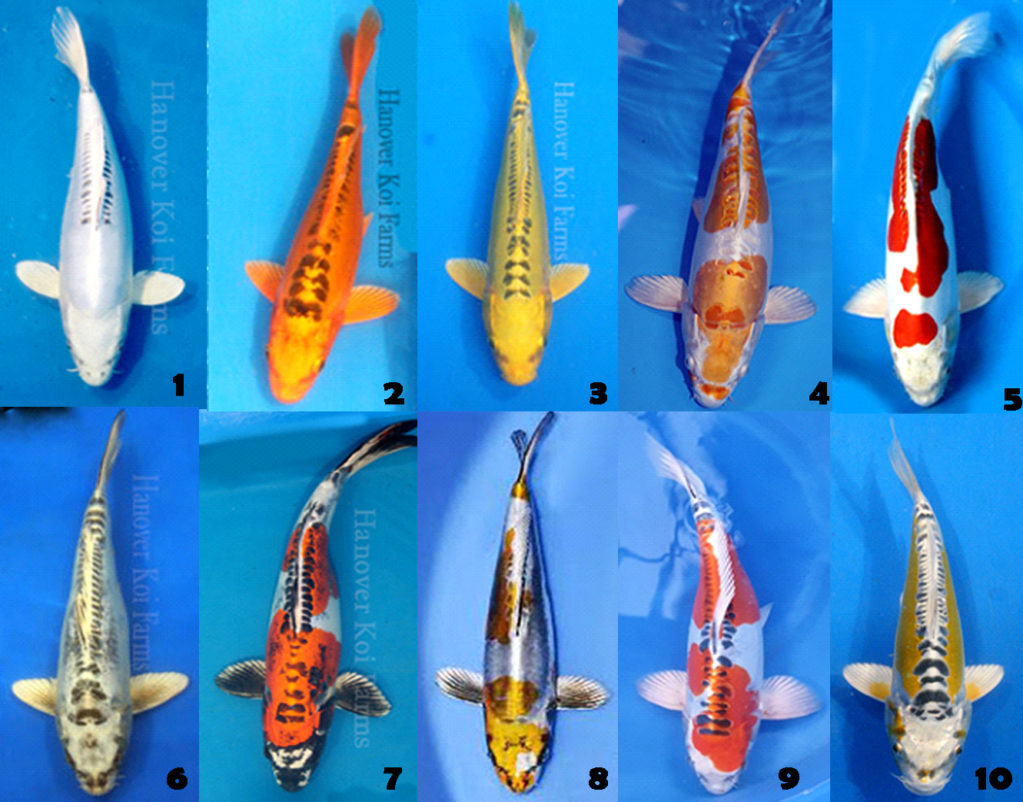
1= Doitsu Gin Matsuba
2= Doitsu Kin Matsuba
3= Doitsu Ki Matsuba
4= Doitsu Hariwake
5= Kikusui
6= Kikokuryu
7= Beni Kikokuryu
8= Kin Kikokuryu
9= Doitsu Kujaku
10= Doitsu Ki Kujaku
Written by John N Fornaro -Hanover Koi Farms
All Rights Reserved 2020
Most of the fish photos are of Hanover Koi Farms fish. However some are not, and were taken off the Internet primarily from Pinterest. Since the photographers and/or owners of these photos are unknown to me I would like to thank them for their contribution to this article to help educate the Koi Hobbyist and some Koi dealers.
